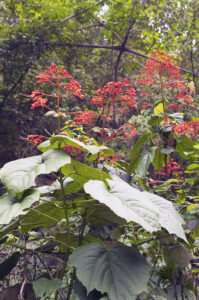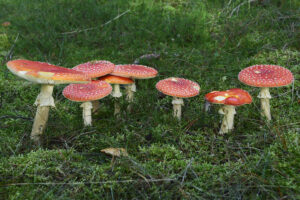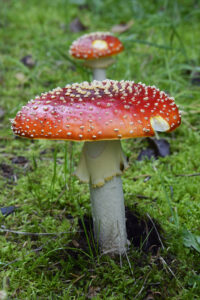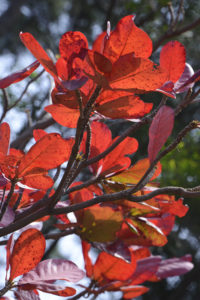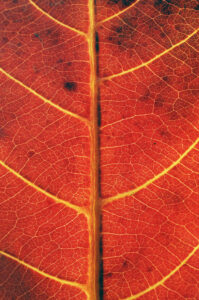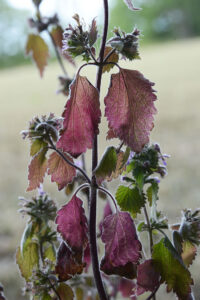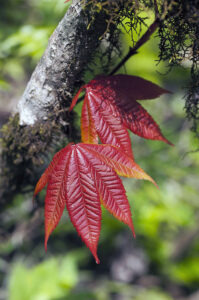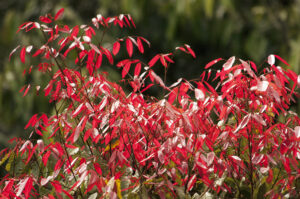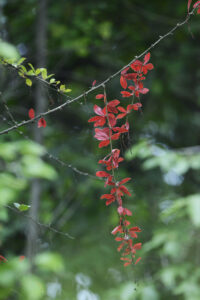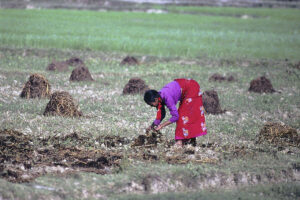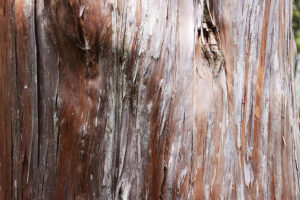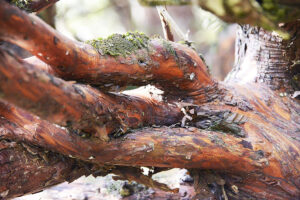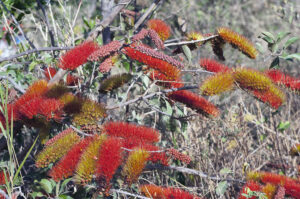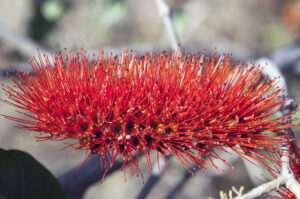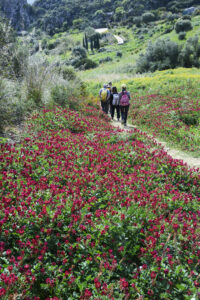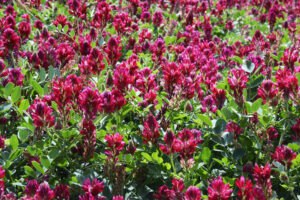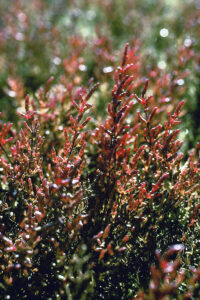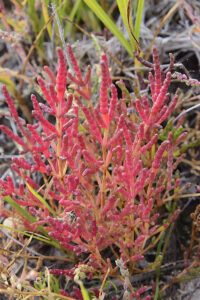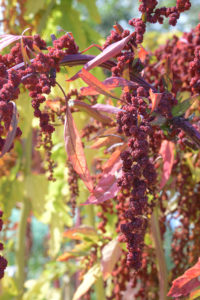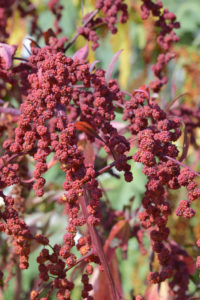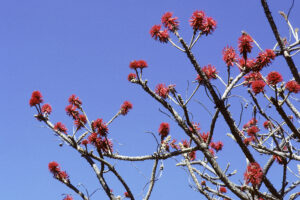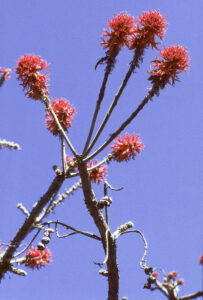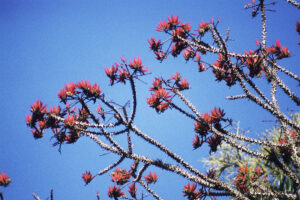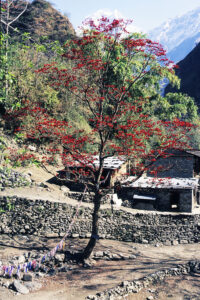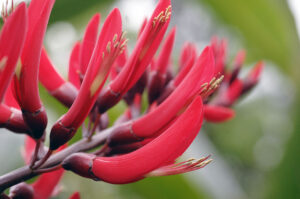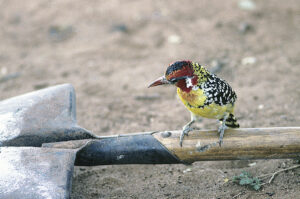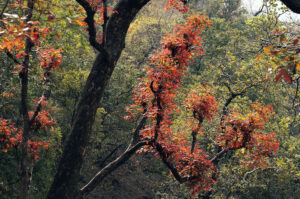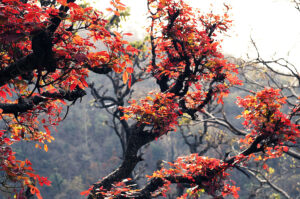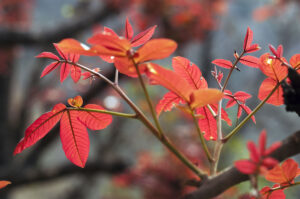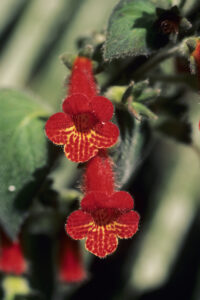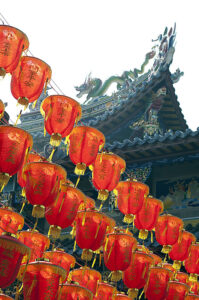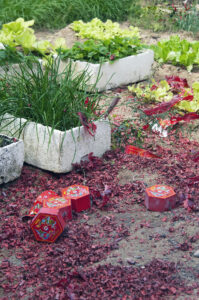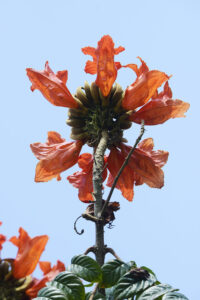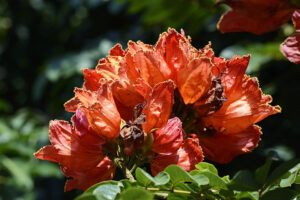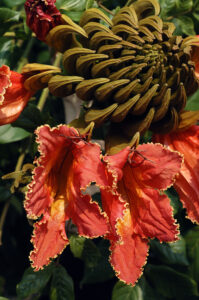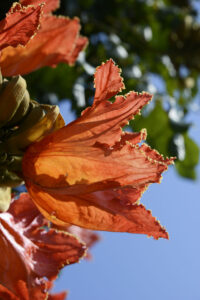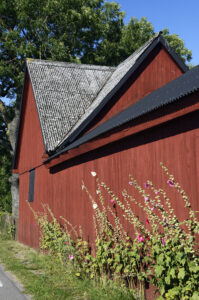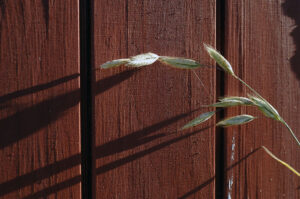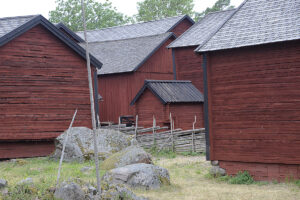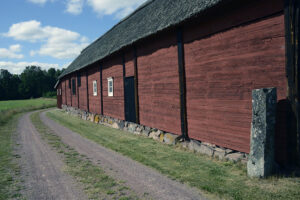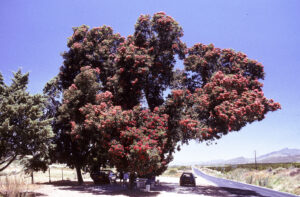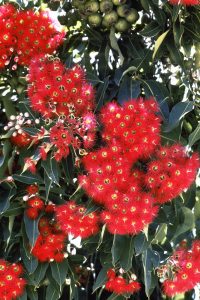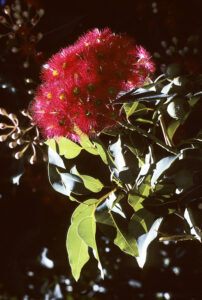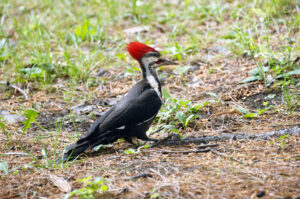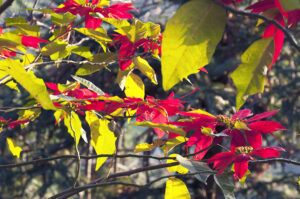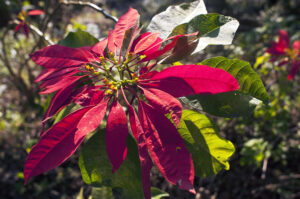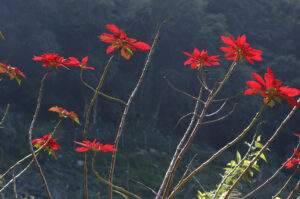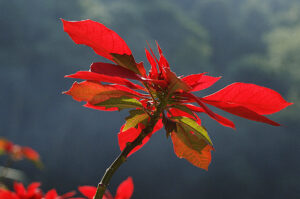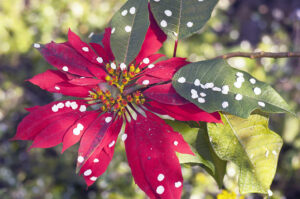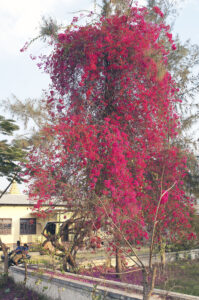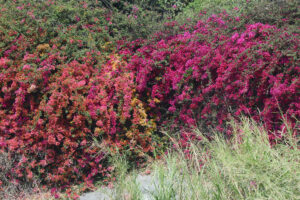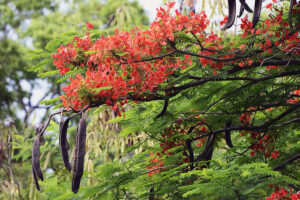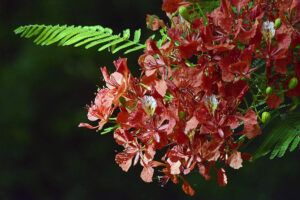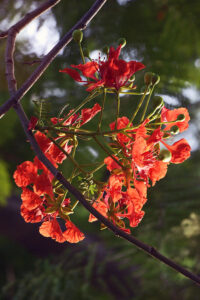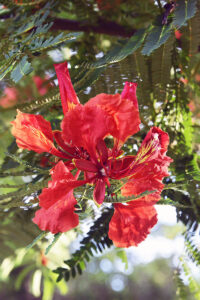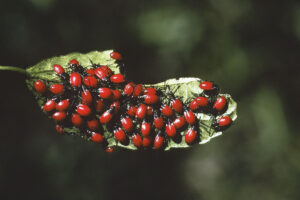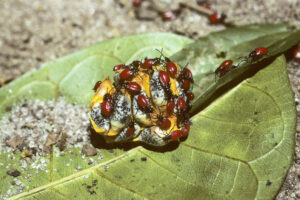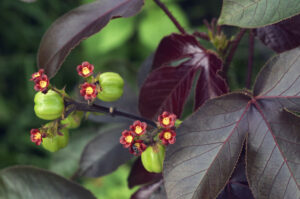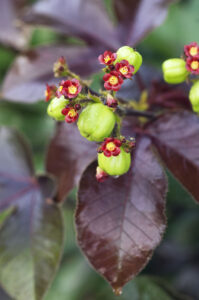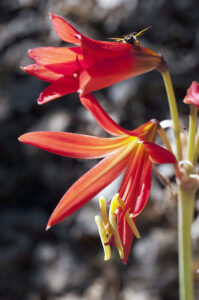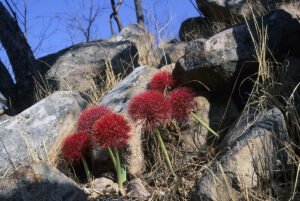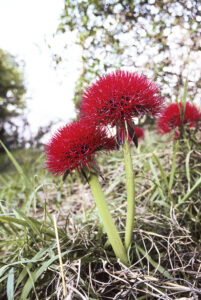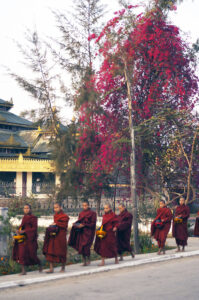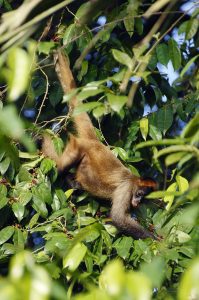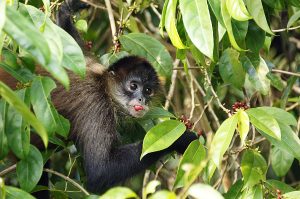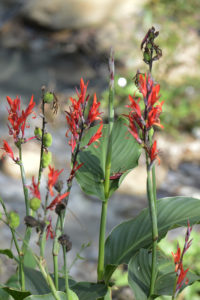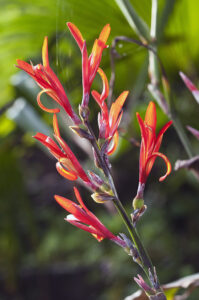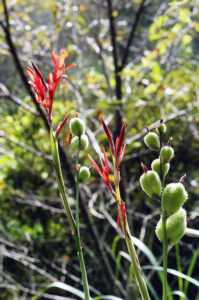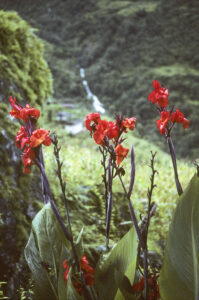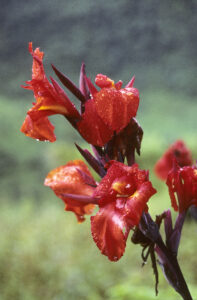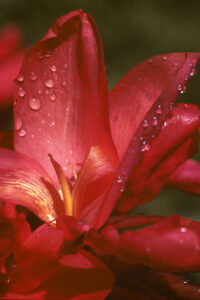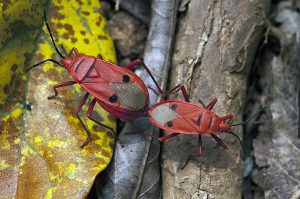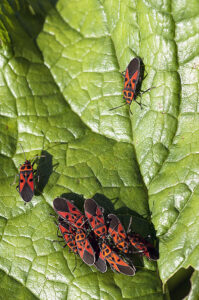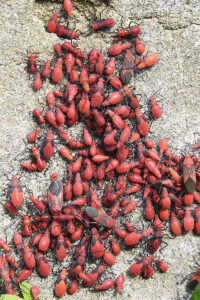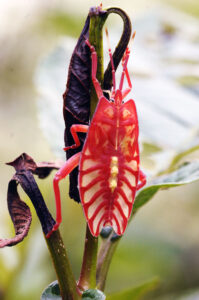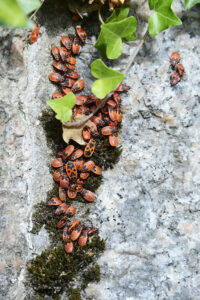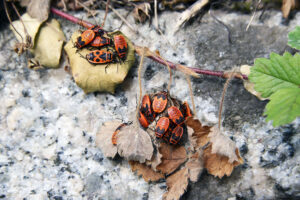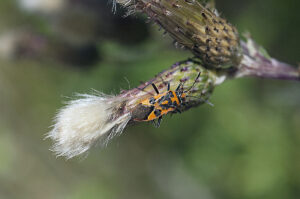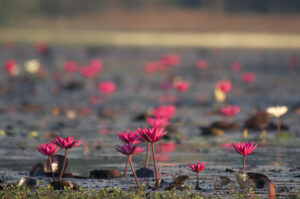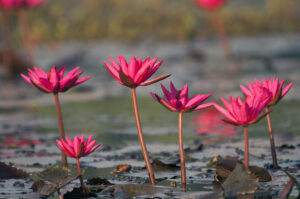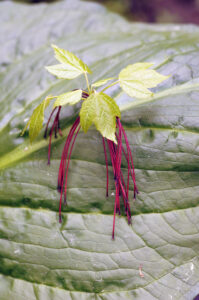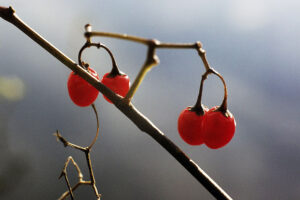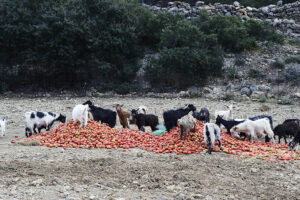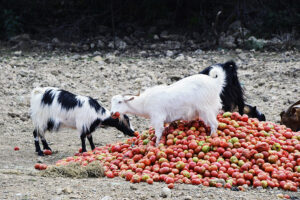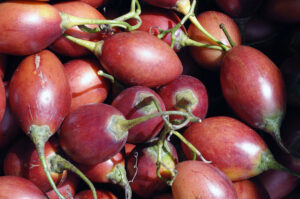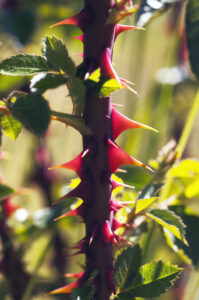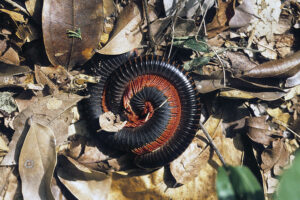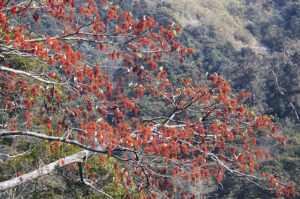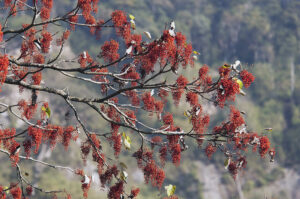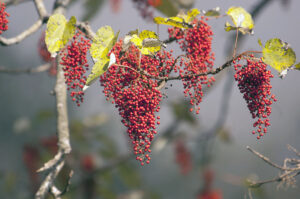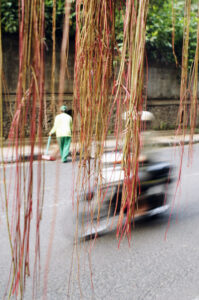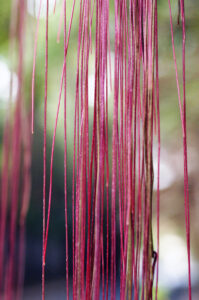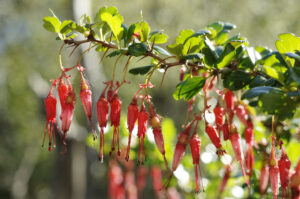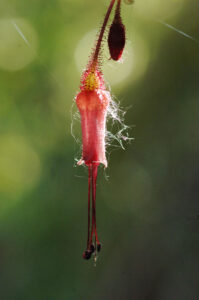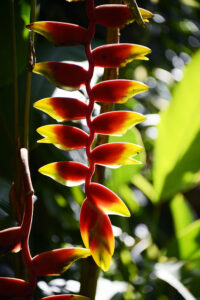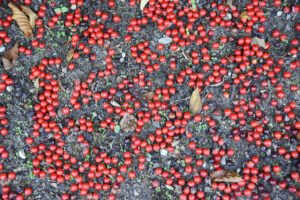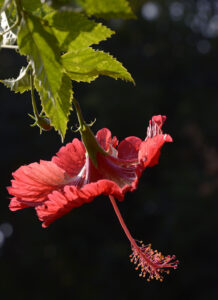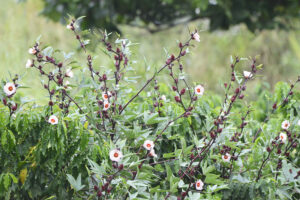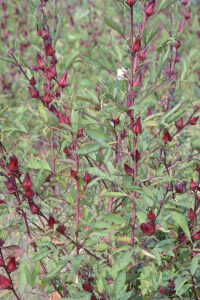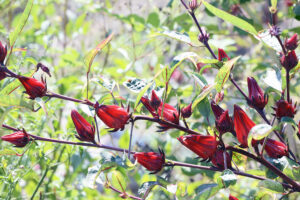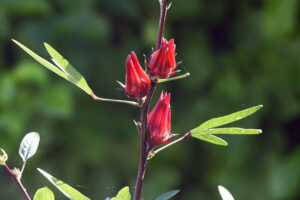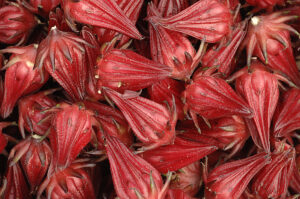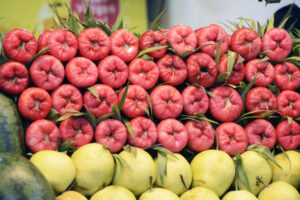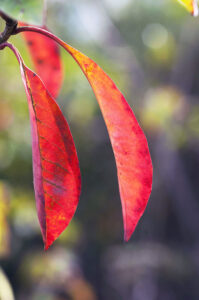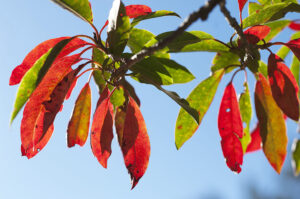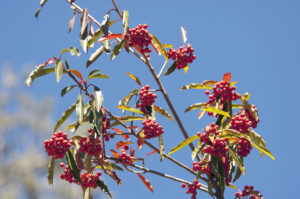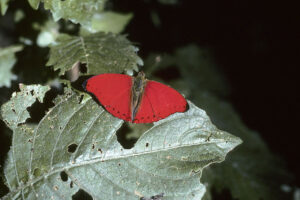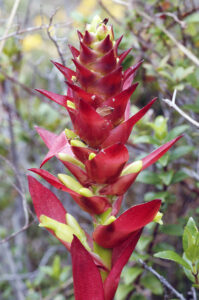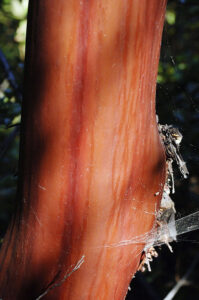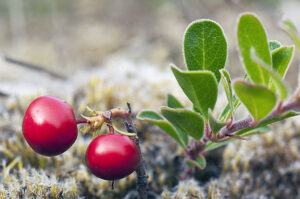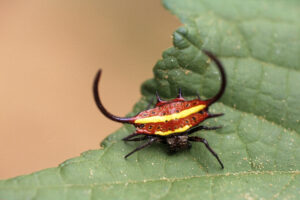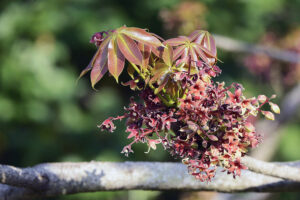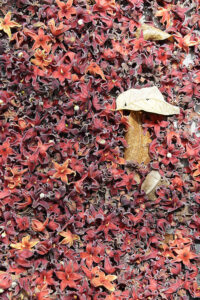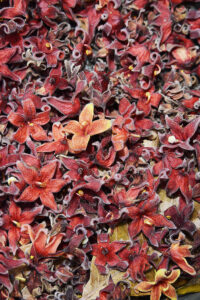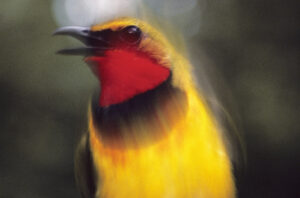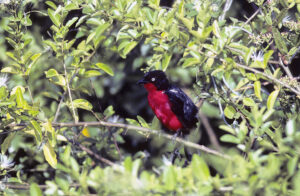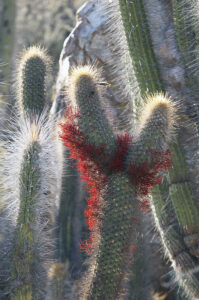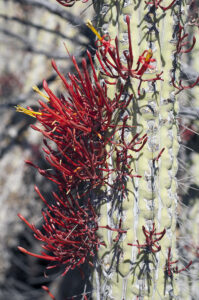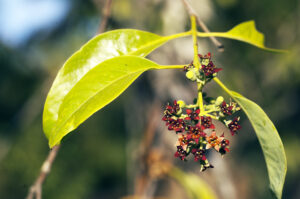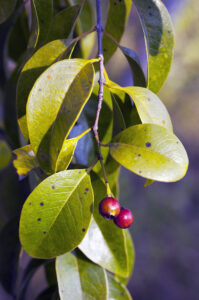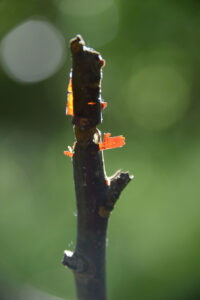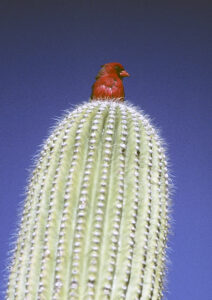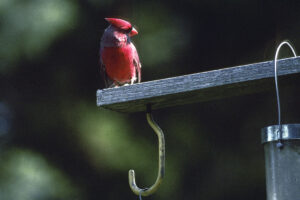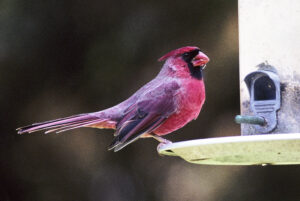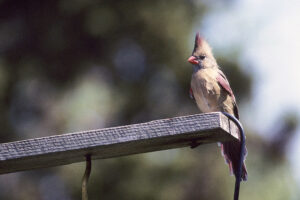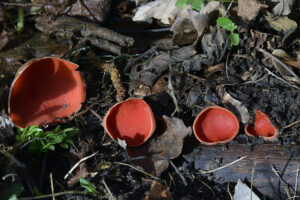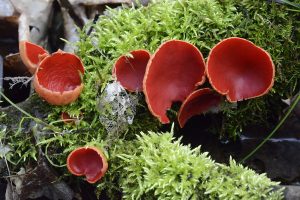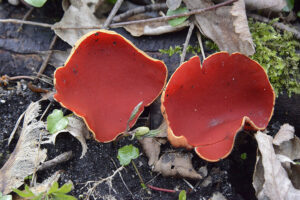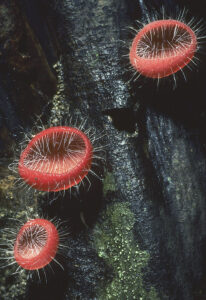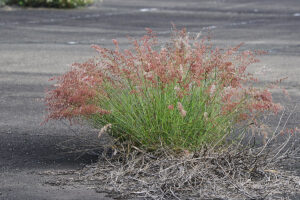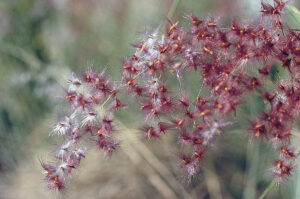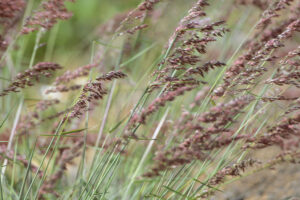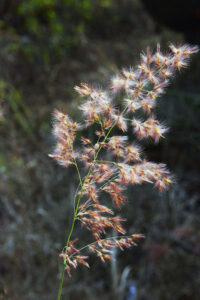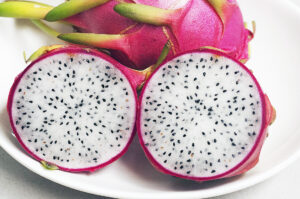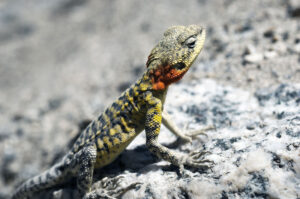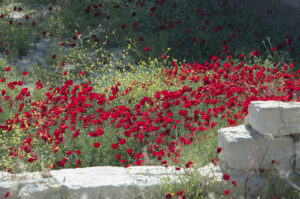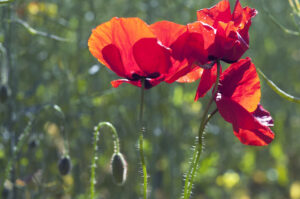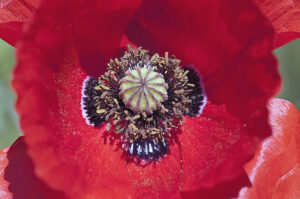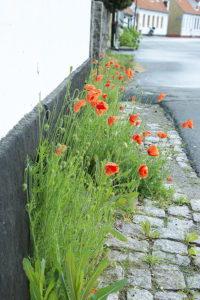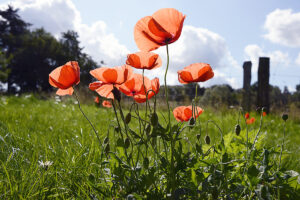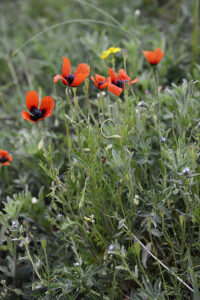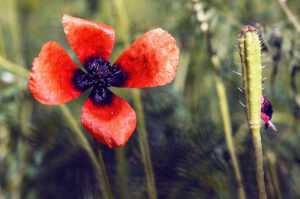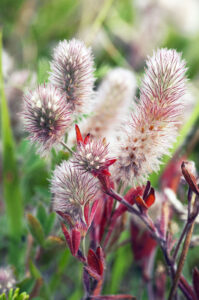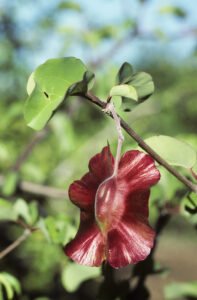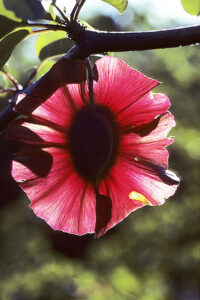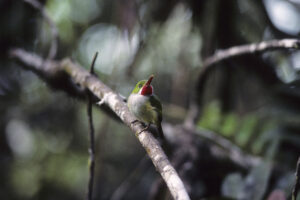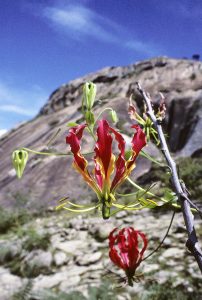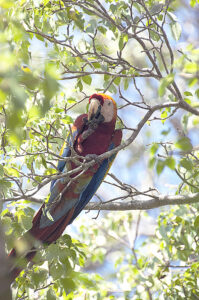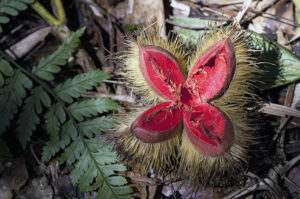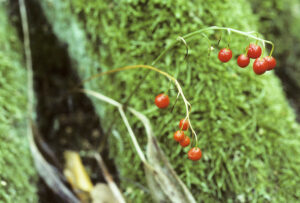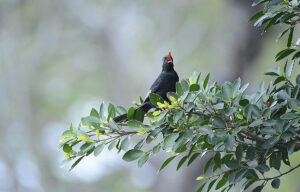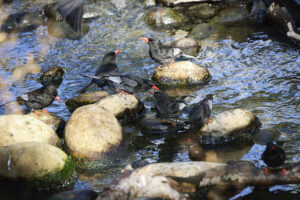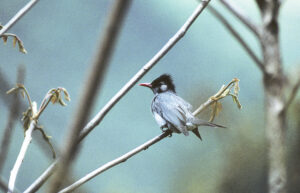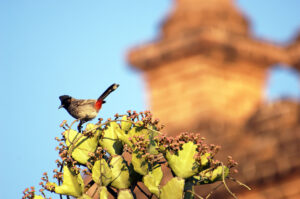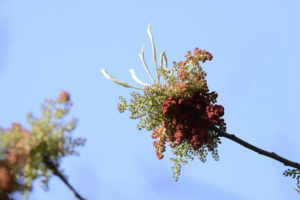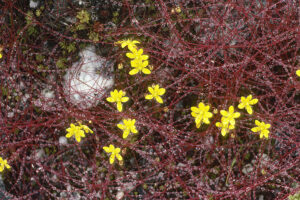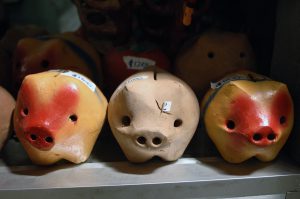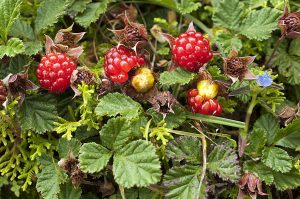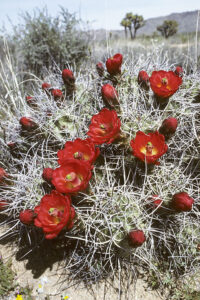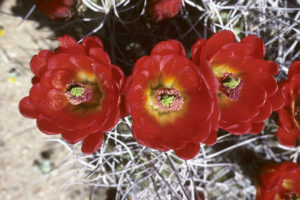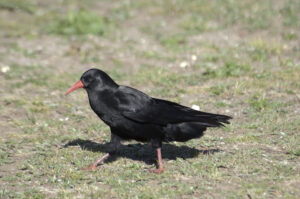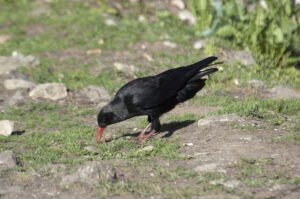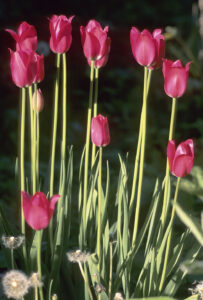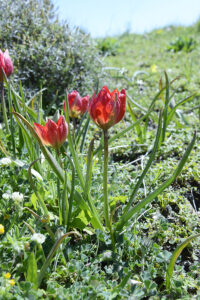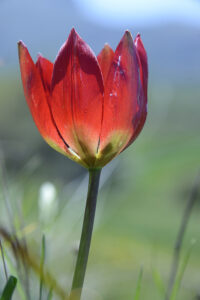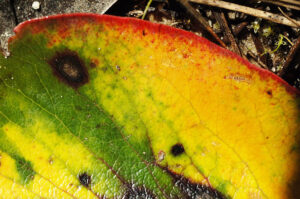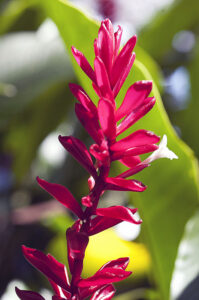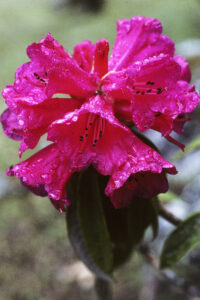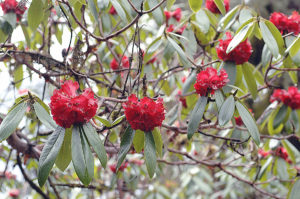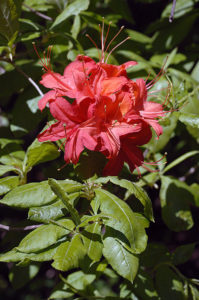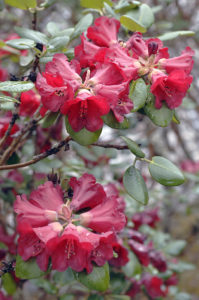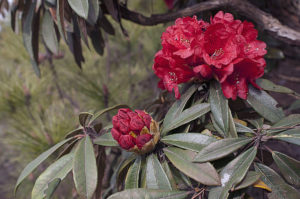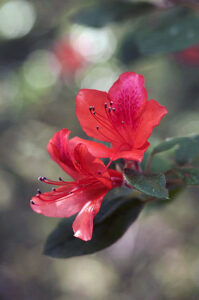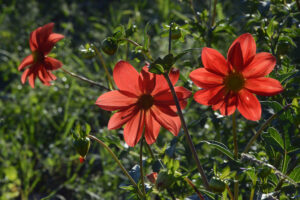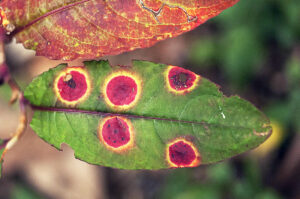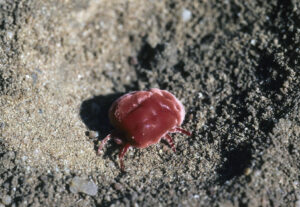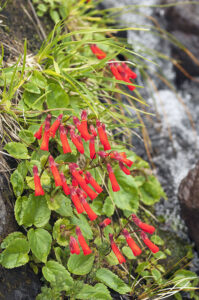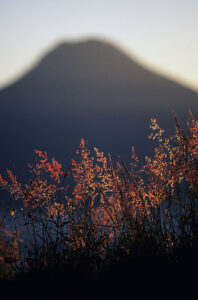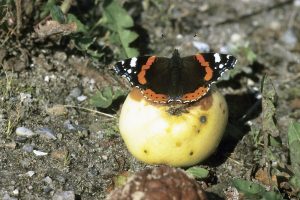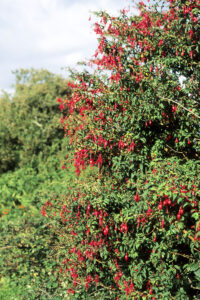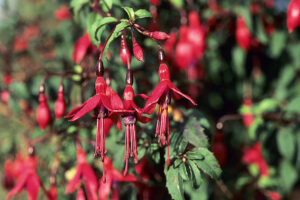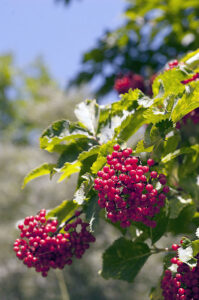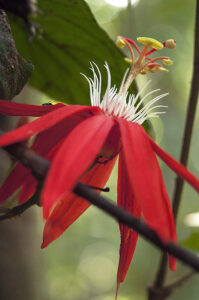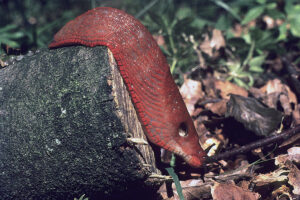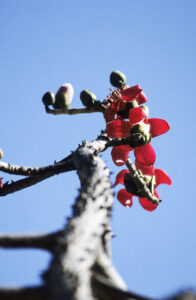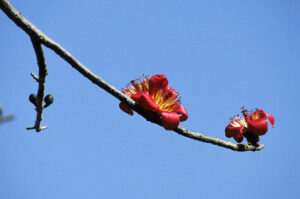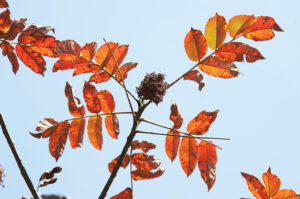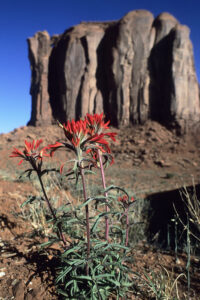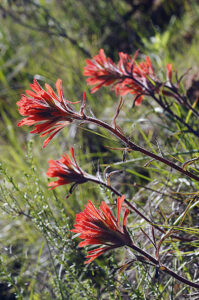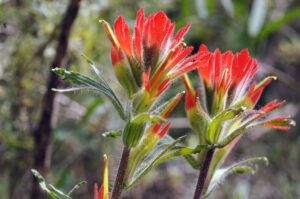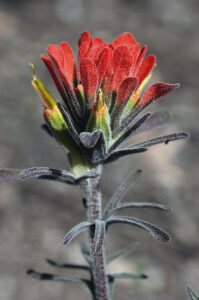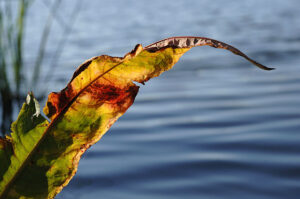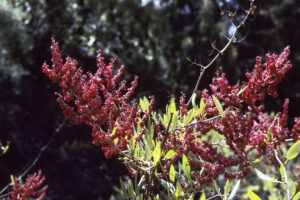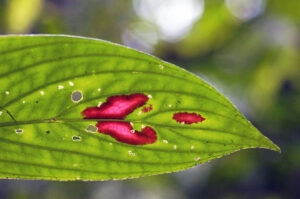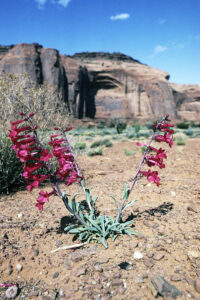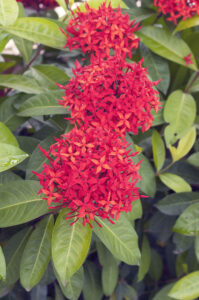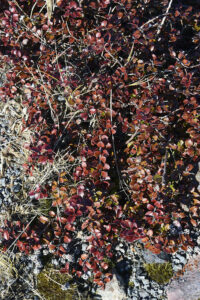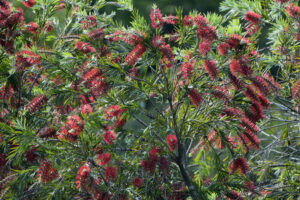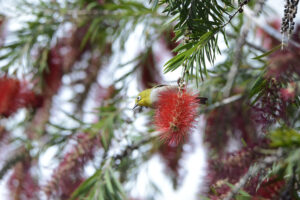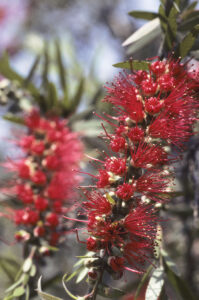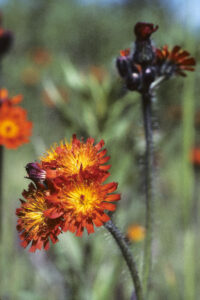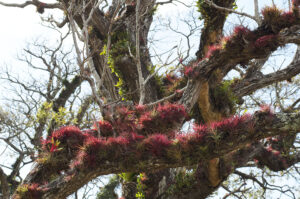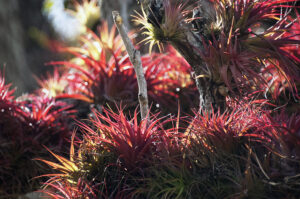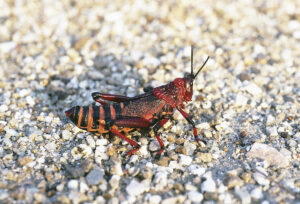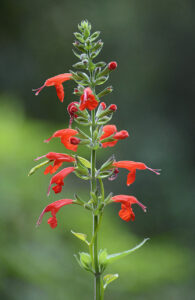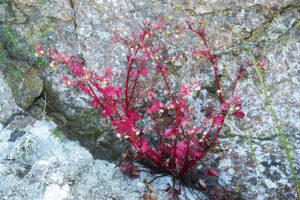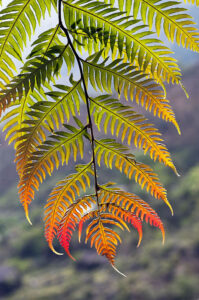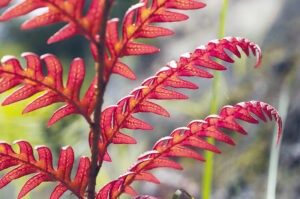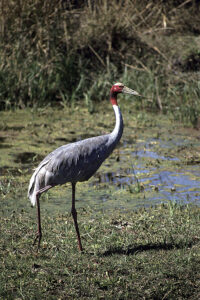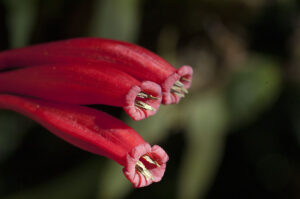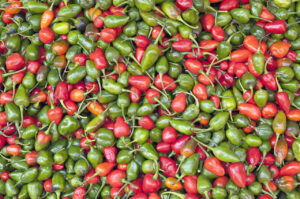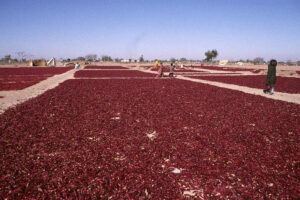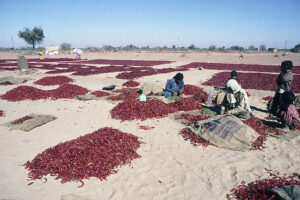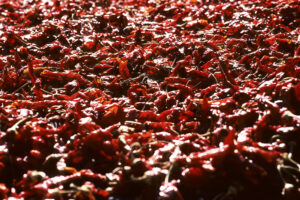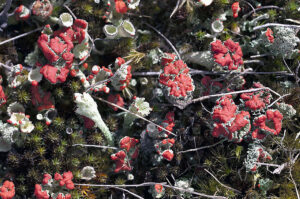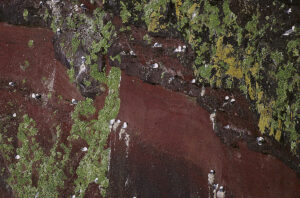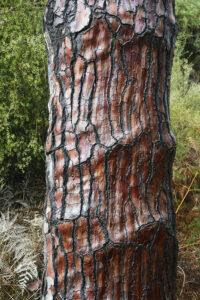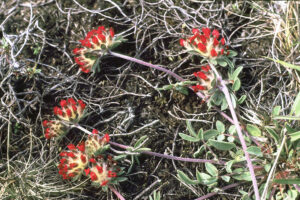In praise of the colour red
Illuminated wooden bridge, leading out to the Ngoc Son Temple in the Hoan Kiem Lake, Hanoi, Vietnam. (Photo copyright © by Kaj Halberg)
Bullfinches (Pyrrhula) are 7 species of thick-billed finches, 5 of which are purely Asian. The Eurasian bullfinch (P. pyrrhula) is widespread from Europe and the Middle East eastwards across temperate areas of Asia to Japan, whereas the Azores bullfinch (P. murina) is restricted to a single island in the Azores.
The generic name is derived from the Greek pyr (‘fire’), alluding to the gorgeous red colour of the male Eurasian bullfinch, and the Latin ulus, a suffix indicating something small.
Red-headed bullfinch (P. erythrocephala) is presented on the page Animals – Birds: Birds in the Himalaya.
Male bullfinches, visiting a bird feeder, Funen, Denmark. (Photos copyright © by Kaj Halberg)
Glorybower (Clerodendrum) is a large genus of the mint family (Lamiaceae), counting about 150 species, which are native to Africa and Asia.
The pagoda flower (C. paniculatum), by some authorities called Javan glorybower, is a stout herb, sometimes growing to 2 m tall. It was named for its spectacular, pyramidal clusters of red or scarlet flowers.
This plant is native to subtropical and tropical Asia, from India eastwards to southern China and Taiwan, and thence through Southeast Asia to Indonesia, the Philippines, and New Guinea. It is widely cultivated and often escapes, making it difficult to determine whether a population is genuinely wild or not.
A close relative, C. infortunatum, is described on the page Plants: Himalayan flora.
Pagoda flower, Changhua, Taiwan. (Photo copyright © by Kaj Halberg)
The red-necked grebe (Podiceps grisegena) was named for its red neck in the breeding plumage. It has a very large distribution, found from Denmark, Sweden, Germany, and the Balkans eastwards to south-western Siberia and Kazakhstan, from eastern Siberia southwards to northern China and Sakhalin, and in north-western North America, eastwards to the Great Lakes.
Incubating red-necked grebe, Copenhagen, Denmark. (Photo copyright © by Kaj Halberg)
The fly amanita (Amanita muscaria) is native to temperate and subarctic forests of the Northern Hemisphere, but has been unintentionally introduced to many countries in the Southern Hemisphere. It is partial to coniferous forests, but may also be encountered in deciduous forests. The typical fly amanita is white with a bright red cap, dotted with white ‘warts’, which are remains of the veil that surrounds the young fungus. Some subspecies have orange or yellowish cap.
This species is famous for its hallucinogenic properties, and, until recently, it constituted an important part in shamanistic rituals of several peoples, including the Sami, semi-nomadic reindeer herders of far northern Scandinavia and Russia. Their shamans wore pointed red hats, symbolizing the mushroom that was their sacrament, and red capes, which symbolized their flight through the air when they consumed the mushroom on their most sacred night of the year – the Winter Solstice (then December 25).
It is generally believed that the Vikings went berserk by eating fly amanita, but this is probably a wrong presumption, as you become rather lethargic by eating it.
The specific name is derived from the Latin musca (‘fly’), alluding to its usage to kill flies. German Catholic Dominican friar Albertus Magnus (c. 1200-1280) records in his work De vegetabilibus that “it is called the fly mushroom because it is powdered in milk to kill flies.”
Fly amanita, Jutland, Denmark. The fungi in the upper picture have not been manipulated. They were really standing this close! (Photos copyright © by Kaj Halberg)
Presumably, it had been decided that the high-altitude Hohuan Shan parking lot in central Taiwan would provide a romantic setting for wedding pictures. Unfortunately, the great day turned out to be foggy and with near-freezing temperatures, so the poor bride must have been frozen stiff in her airy garment, while posing for several minutes in front of a team of professional photographers, clad in down jackets. (Photos copyright © by Kaj Halberg)
Numerous plant species attain red foliage at some point in their life cycle. Young leaves of many species are bright red, signalling a high content of toxins, compared to green leaves. Thus, they are rather unpalatable to insects and are often avoided by them.
In arctic and temperate areas, most broad-leaved trees and bushes shed their foliage in autumn. Before falling, the leaves turn various colours, often red. In subtropical areas, a number of trees also attain red foliage, mostly in the winter months.
A large number of pictures, depicting plants with red foliage, are shown on the page Autumn.
The native area of the beach almond (Terminalia catappa), also known as country almond, Indian almond, Talisay tree, and umbrella tree, is unknown. Today, this species is widely distributed in most tropical and some subtropical areas of the world, growing in a wide range of habitats.
Three of its popular names stem from the similarity of its fruits to those of the true almond (Prunus amygdalus), but the two species are not at all related, as beach almond belongs to the family Combretaceae, whereas the true almond is in the rose family (Rosaceae).
Gorgeous winter leaves of beach almond, Taiwan. Others are shown on the page Autumn. (Photos copyright © by Kaj Halberg)
Black horehound (Ballota nigra), a member of the mint family (Lamiaceae), is native from Denmark and southern Sweden southwards to northern Africa, and from Portugal eastwards to European Russia and Iran. The common name is derived from Old English harehune, where the first part means ‘hoary’ (downy-hairy), whereas the last part is of unknown origin, but has nothing to do with hounds.
Black horehound often gets reddish foliage in autumn. This picture is from Funen, Denmark. (Photo copyright © by Kaj Halberg)
Campbell’s maple (Acer campbellii) is a large tree, growing in forests and shrubberies in the Himalaya, at elevations between 2,100 and 3,600 m. It is distributed from western Nepal eastwards to Myanmar, and thence northwards to the Chinese provinces Yunnan and Sichuan.
Young leaves of Campbell’s maple are bright red, here photographed in the Annapurna area, central Nepal. (Photo copyright © by Kaj Halberg)
New red leaves on a forest tree, Silent Valley National Park, Kerala, India. (Photo copyright © by Kaj Halberg)
Many species of barberry (Berberis) attain red foliage in autumn and winter. This picture shows B. ceratocarpa, observed in the Lower Langtang Valley, central Nepal. This species is described on the page Plants: Himalayan flora 1. (Photo copyright © by Kaj Halberg)
Indian and Nepalese women love colourful garments. Several examples are shown below.
Slender girl in a red sari, Seventri, Rajasthan. (Photo copyright © by Kaj Halberg)
Four women, one wearing a bright red sari, walk in single file, carrying heavy loads on their head, Rishikesh, Uttarakhand. (Photo copyright © by Kaj Halberg)
Dressed in colourful saris, these village women are on their way to attend Hindu New Year at a temple in Charbhuja, Rajasthan, dedicated to the monkey god, Hanuman. – Some Hindu festivals are described on the pages Religion: Hinduism, and Travel episodes – India 1991: Attending Hindu festivals in Rajasthan. (Photos copyright © by Kaj Halberg)
Whatever Indian village women are doing, they always bring their baby along. This woman has been collecting firewood in the scrub forest in Keoladeo National Park, Rajasthan. (Photo copyright © by Kaj Halberg)
This brightly dressed village woman is spreading manure in a field near Sauraha, southern Nepal. (Photo copyright © by Kaj Halberg)
New Zealand cedar (Libocedrus bidwillii) is a conifer, which is restricted to New Zealand, where it grows in temperate rainforests at altitudes between 250 and 1,200 m. This species is listed as near-threatened, and, apart from logging, the main threat is from browsing Australian brushtail possums (Trichosurus vulpecula), which may sometimes kill cedars. This introduced pest is presented on the page Nature: Invasive species.
New Zealand cedar was named in honour of British botanist and explorer John Carne Bidwill (1815-1853), who investigated plant life in New Zealand and Australia, discovering several species new to science. In 1851, while marking out a new road in Queensland, Bidwill got lost and was without food for eight days. He eventually succeeded in cutting a way through the scrub with a pocket hook, but never properly recovered from starvation, and died in March 1853, 38 years old. (Source: Serle, P. 1949. Bidwill, John Carne (1815-1853). Dictionary of Australian Biography. Angus & Robertson)
Bark of New Zealand cedar is often reddish. These trees were photographed in Tongariro National Park. (Photos copyright © by Kaj Halberg)
Combretum fruticosum, popularly called orange flame vine or chameleon vine, is a member of the family Combretaceae, which is distributed from Mexico southwards to northern Argentina. This plant may grow as a bush, to 3 m tall, but is mostly a climber, which may reach a length of 10 m or more. The striking inflorescences are red, orange, or yellowish, to 16 cm long, leaves entire, to 16 cm long and 8 cm broad.
Inflorescences of Combretum fruticosum, Cordillera de Guanacaste, Costa Rica. (Photos copyright © by Kaj Halberg)
Colourful dyes are much utilized in the Indian culture, for decoration as well as offerings to Hindu gods during festivals.
Selling dyes at markets in Sonpur, Bihar (top), and in Haridwar, Uttarakhand. (Photos copyright © by Kaj Halberg)
The gorgeous Italian sainfoin (Sulla coronaria, previously known as Hedysarum coronarium) is restricted to the western part of the Mediterranean region, native to southern Italy, Spain, Morocco, Algeria, Tunisia, and Malta. It is widely cultivated as animal fodder and for production of hay and honey. It grows to about 1.5 m tall, and has pinnately divided leaves with up to 11 leaflets.
Large growth of Italian sainfoin, Castella di Scopello, Sicily. (Photos copyright © by Kaj Halberg)
Common glasswort (Salicornia europaea) is one among 15 species of this genus of the cockscomb family (Amaranthaceae), which are native to Europe, Asia, Africa, and North America. They are mainly coastal, growing in fine-grained mire, which becomes exposed at low tide, in salt marshes, and among mangroves. Inland, they are also found in salt marshes.
Common glasswort is edible, raw or cooked, often steamed and coated in butter or olive oil. Due to its high content of salt, it must be cooked in plenty of water, and no salt added.
The generic name is probably derived from the Latin sal (‘salt’), which refers to the habitat of these plants, and cornu (‘horn’), referring to the tip of the shoots, which somewhat resembles a horn. Other common names include pickleweed, picklegrass, and marsh samphire, the latter believed to be a corruption of the French name (herbe de) Saint-Pierre, meaning ‘St. Peter’s herb’. In North America, Salicornia virginica is occasionally sold under the names sea beans, samphire greens, or sea asparagus.
Common glasswort often turns various shades of red in autumn, like these, photographed in salt marshes on the island of Langli, western Jutland, and on the Mols Peninsula, both in Denmark. (Photos copyright © by Kaj Halberg)
Another member of the cockscomb family is quinoa (Chenopodium quinoa), which was first cultivated in the Andes about 5,000 years ago, in the beginning as animal feed, and for human consumption at least 3,000 years ago, at Lake Titicaca. (Source: A. Kolata 2009. Quinoa: Production, Consumption and Social Value in Historical Context. Department of Anthropology, University of Chicago)
Its seeds are rich in protein, fiber, B vitamins, and minerals, in greater amounts than in many other grains. The name quinoa is derived from Quechua kinwa or kinuwa.
To the Incas, this crop was sacred, called chisoya mama (‘mother of all grains’). Traditionally, the Inca emperor was the one to sow the first seeds of the growing season, using ‘golden implements’. (Source: H. Popenoe 1989. Lost crops of the Incas: little-known plants of the Andes with promise for worldwide cultivation. National Academy Press, Washington, D.C.)
When the Spanish conquistadors arrived in the Andes, they refused to acknowledge the qualities of quinoa, calling it ‘food for Indians’. They even forbade its cultivation at one point, and the Incas were forced to grow wheat instead. (Source: D.W. Gade 1999. Nature and culture in the Andes. University of Wisconsin Press)
Fruits of quinoa often attain various shades of red. – Taichung, Taiwan. (Photos copyright © by Kaj Halberg)
Ganesh is a Hindu deity, who has a human body, but the head of an elephant. Traditionally, he is regarded as the youngest son of the great god Shiva and his female consort Parvati. He is often depicted with his four arms raised in a friendly gesture, while standing on his mount – a rat. He is a very popular deity, and before making important decisions it is wise to place a malla (flower garland) on an image of Ganesh, while saying a prayer.
There are various legends as to how Ganesh got his elephant-head. One is related on the page Religion: Hinduism.
Sculpture, depicting Ganesh, with offerings of red dye and flower petals, Kathmandu, Nepal. (Photo copyright © by Kaj Halberg)
Another Hindu deity is Naga, the Indian cobra (Naja naja), which is sacred and often revered.
Offerings of rice and red dye have been placed on this Naga sculpture in Kathmandu, Nepal. (Photo copyright © by Kaj Halberg)
Coral trees (Erythrina) are a large genus, comprising more than 100 species of deciduous trees in the pea family (Fabaceae), distributed in tropical and subtropical areas around the world.
The generic name is derived from Ancient Greek erythros (‘red’), like the common name referring to the wonderful scarlet, coral-red, or orange-red flowers of the genus.
These flowers are much visited by birds, including bulbuls and sunbirds, which feed on the nectar, and parrots, which eat the entire flower.
Erythrina abyssinica is distributed from the Central African Republic, Sudan, and Eritrea southwards to Angola, Botswana, and Mozambique. Necklaces are made from its seeds, which are also used as fish poison. The wood is used for carving, and for making beehives and drums.
Erythrina abyssinica, near Iringa, Tanzania. (Photos copyright © by Kaj Halberg)
Erythrina stricta, which grows to 12 m tall, is characterized by numerous sharp, whitish prickles on trunk and branches. Its native range is from the Indian Peninsula eastwards across Indochina to south-western China.
Erythrina stricta, Periyar National Park, Kerala, India (top), and Kali Gandaki Valley, central Nepal. (Photos copyright © by Kaj Halberg)
Erythrina crista-galli, popularly known as the cockspur coral tree, and in Latin America as ceibo, is a small tree, growing to 10 m tall, with a trunk diameter up to 50 cm. It is native to southern Brazil, Argentina, Uruguay, and Paraguay, but is widely planted as an ornamental tree elsewhere in warmer countries. It is the national tree of Argentina, and the flower is the national flower of Uruguay.
The specific name is Latin, meaning ‘cock’s comb’.
Erythrina crista-galli, Yeliou Geopark, Taiwan. (Photo copyright © by Kaj Halberg)
Like most men in the state of Rajasthan, north-western India, these men are wearing turbans. (Photo copyright © by Kaj Halberg)
The red-and-yellow barbet (Trachyphonus erythrocephalus) is aptly named, as its plumage is predominantly red and yellow. This gorgeous bird is found in East Africa, from South Sudan, Ethiopia and Somalia, southwards to northern Tanzania. Its feathers are used ornamentally by several tribal peoples, including the Masaai.
The red-and-yellow barbet is often very confiding. This one is sitting on the shaft of a shovel in our camp, Tarangire National Park, Tanzania. (Photo copyright © by Kaj Halberg)
The lac tree, or kusum tree (Schleichera oleosa) is a deciduous, sometimes evergreen tree, to 40 m tall, with a broad and shady crown, noted for its bright red or scarlet spring foliage. It is distributed from India and Sri Lanka eastwards to Southeast Asia, and thence southwards to Indonesia.
This species is utilized medicinally. The fruits are edible, and an oil, called kusum, is extracted from the seeds. It is host to a lac insect, Kerria lacca, which is native to India.
The generic name was given in honour of Swiss botanist Johann Christoph Schleicher (1770-1834), and the specific name is Latin, meaning ‘rich in oil’.
In the Himalaya, the lac tree is restricted to the foothills, found up to an elevation of about 1,000 m. These were photographed near Rishikesh, Uttarakhand. (Photos copyright © by Kaj Halberg)
Kohleria is a genus of shrubby herbs of the family Gesneriaceae, comprising about 19 species, distributed in Central and South America. Most species have brightly coloured flowers, and they have been popular ornamental plants in Europe and North America for more than 150 years.
The gorgeous Kohleria spicata is found from southern Mexico eastwards to Venezuela, and thence southwards to Peru. It was formerly utilized in traditional folk medicine.
Kohleria spicata, Tikal National Park, Guatemala. (Photo copyright © by Kaj Halberg)
The prevalent religion in Taiwan is a unique blend of Buddhism and Daoism, described in depth on the page Religion: Daoism in Taiwan. Below is a number of pictures related to Daoism.
Traditional paper lanterns, for the major part bright red, adorn almost all Daoist temples in Taiwan. Numerous pictures, depicting such lanterns, are presented on the page Culture: Lamps and lights.
Paper lanterns in a Daoist temple in the city of Taichung. (Photo copyright © by Kaj Halberg)
Song Bo Chin, a Daoist temple in the town of Ershuei. In Chinese mythology, the dragon is a symbol of power, strength, and good luck, and Daoist temples abound with images of these creatures. (Photos copyright © by Kaj Halberg)
In Daoist temples, people often write wishes on small pieces of paper and glue them on walls, pillars, and other places, hoping that the gods will favour them.
Small pieces of red paper with written wishes, glued on the inside of a bell, Mazu Temple, Beigang. (Photo copyright © by Kaj Halberg)
Exploding fireworks are a very common part of any Daoist festival in Taiwan. Almost all fireworks are wrapped in red paper.
Remains of exploded fireworks during a festival for the Mother Goddess Mazu, Pitou (top), and during a festival on Siao Liouchou Island, honouring Wang-yeh, the god of disease. (Photos copyright © by Kaj Halberg)
In certain fishing communities in southern Taiwan, people still celebrate the so-called Boat Burning Festival. Prior to this festival, a complete, richly decorated wooden boat has been constructed, only to be burned as an offering to the god of diseases, Wang-yeh, hoping that he will spare the people of the plague and other dreadful diseases. In former times, the burning boat was pushed out to sea, ceremonially carrying the diseases away, but this practice has now been abandoned, and the boat is burned on land.
During a Boat Burning Festival, celebrated in the village of Jiading, near Kaohsiung, this pilgrim carries fake swords across his back. (Photo copyright © by Kaj Halberg)
These little girls are dressed up for a dancing performance during Chinese New Year, celebrated in the Fusing Mazu Temple, Xiluo, Taiwan. (Photo copyright © by Kaj Halberg)
Both the lion and the tiger have been a common motif in Chinese art for millenia, and when Daoism was brought to Taiwan by Chinese immigrants, it was only natural that they were commonly depicted in Daoist temples, although neither of the two animals have ever lived on the island.
In Chinese lore, the lion is a mythological creature, often in the role as protector. Many sculptures in Taiwan depict male lions with a paw placed on a globe-like item, which is in fact an embroidered ball. In the old days, balls, made from discarded clothes, were presented by children as offerings to temples – a symbol of yang (light forces) and friendship.
Lion sculptures are also often placed as guardians outside temples and on Daoist graves. Several pictures, depicting such sculptures, are shown on the pages Religion: Daoism in Taiwan, and Culture: Graves.
During Daoist festivals, so-called lion dances often take place in front of temples and shops. Usually this dance is performed by two men, hidden under a gaily coloured cloth, which acts as the body of the lion, whereas a lion mask is held by the man in front.
These lion sculptures, adorned with red ribbons, were photographed outside the Donglong Temple, Donggang, Taiwan. (Photos copyright © by Kaj Halberg)
This tiger sculpture was also observed at the Donglong Temple. (Photo copyright © by Kaj Halberg)
During a Daoist festival in the city of Taichung, a lion dance is performed in front of a shop. Supposedly, this will increase the sales. (Photo copyright © by Kaj Halberg)
In this picture, lion dance dresses have been placed on a drum. The man in the background is dressed as a bajajiang (a benevolent, devil-like being). (Photo copyright © by Kaj Halberg)
African tulip tree (Spathodea campanulata) is native to sub-Saharan Africa, from Sierra Leone eastwards to Ethiopia, and thence southwards to Angola and Zambia. Due to its wonderful flowers, it is widely cultivated in almost all warmer parts of the world. The pollen and stamens are popular food items among many bird species, including the Asian black bulbul (Hypsipetes leucocephalus), which is presented elsewhere on this page.
Flowers of African tulip tree, Taichung, Taiwan. (Photos copyright © by Kaj Halberg)
Mankind has utilized red iron oxide as dyeing pigment for thousands of years, found in cave paintings of southern France and northern Spain. The knowledge that metal oxides are often present in pits, containing sulphurous ore, is also very old. The well-known ‘Swedish-red’, so common on wooden houses in Sweden, originated in copper mining in Falun, Dalarna. After being dried, the mud from the mining gives a yellow colour, which, after being heated, turns red.
In a letter to the manager of the construction at Stockholm Castle, King Johann III (1537-1592) orders him to purchase ‘rust lead’ or ‘pit bran’, as the king wanted all roofs of his castle to be painted red. In Sweden, in the 1600s, it was still unusual to paint your house, and tar was mixed with the colour pigments to conserve the wood.
During the 1700s, industrial production of the red pigment started in earnest. From 1764, the dye was produced at the Falu Gruva in Falun, and in the 1800s, it became increasingly common for laymen to paint their houses with it. In 1861, 900 tons were produced, and in the 1900s, production varied between 1000 and 2000 tons.
In 1992, the Falu Gruva closed down after more than a thousand years of pit-mining – only production of the red dye continued. In 2012, about 500 tons of pigment was produced, corresponding to 1,900,000 liters of ’Swedish-red’ paint. (Source: falurodfarg.com/om-foretaget/det-finns-bara-en-falu-rodfarg)
Below is a collection of pictures, showing buildings painted with ‘Swedish-red’.
Typical Swedish farm, Gillsätra, Öland, Sweden. The flowers are hollyhock (Alcea rosea). (Photos copyright © by Kaj Halberg)
Dilapidated barn, Washington, New Jersey, United States. (Photo copyright © by Kaj Halberg)
In this picture, fruiting spikes of soft brome (Bromus hordeaceus) cast long shadows on a fisherman’s shed near Roskilde Fjord, Zealand, Denmark. This grass species, in America known as bull grass or soft cheat, is native to Europe and northern Asia, and has also become naturalized in many other places. (Photo copyright © by Kaj Halberg)
Stensjö By is a protected village north of Oscarshamn, Småland, Sweden. (Photo copyright © by Kaj Halberg)
House in Valparaiso, Chile. (Photo copyright © by Kaj Halberg)
Farm house, northwest of Kalmar, south-eastern Sweden. (Photos copyright © by Kaj Halberg)
Farm house, stone wall, and old road marker, reading ’10 miles to NO.EK (whatever that may mean), 1773′. – Near Wilton, Connecticut, United States. (Photo copyright © by Kaj Halberg)
Corymbia is a genus of trees, comprising about 90 species, closely related to Eucalyptus. They are native to Australia and New Guinea.
Corymbia ficifolia, popularly known as red-flowered gum, and scientifically formerly as Eucalyptus ficifolia, is endemic to a rather small area in south-western Australia. However, due to its gorgeous flowers, it is one of the most commonly planted ornamental ‘eucalypus’ species. It grows to about 12 m tall, from December to May displaying an abundance of scarlet, pink, or orange flowers.
The specific name is derived from the Latin ficus (‘fig’) and folium (‘leaf’), alluding to the similarity of its leaves to those of some species of fig trees.
A large specimen of Corymbia ficifolia, Citrusdal, South Africa, displaying a profusion of gorgeous flowers. (Photos copyright © by Kaj Halberg)
The pileated woodpecker (Dryocopus pileatus) is distributed across southern Canada and the eastern half of the United States, southwards to Texas and Florida, and also in the Pacific States, southwards to California.
The term pileated refers to the prominent red crest of this bird, from the Latin pilleus (‘cap’) and atus (‘resembling’), thus ‘with a cap-like (crest)’.
Male pileated woodpecker, feeding on the ground, Great Smoky Mountains National Park, Tennessee. The female has a black moustachial stripe. (Photo copyright © by Kaj Halberg)
Poinsettia (Euphorbia pulcherrima) is a gorgeous species of spurge, a shrub or small tree growing to 4 m tall. This plant, which was first encountered by Europeans in the early 1800s, is native to Mexico and Central America, but has been introduced to most warmer areas of the globe as an ornamental.
A popular name of the plant is Christmas star. From the 17th Century, Franciscan monks in Mexico included the plant in their Christmas celebrations. The star-shaped pattern of the bracts was said to symbolize the Star of Bethlehem, and their bright red color represented the blood of the crucified Jesus.
In Mexico and Guatemala, poinsettia is called Flor de Noche Buena, meaning ‘Flower of the Good Night’ (i.e. Christmas Eve). In Spain, it is known as Flor de Pascua (‘Easter flower’), and in Chile and Peru, it is called La Corona de los Andes (‘Crown of the Andes’).
The name poinsettia commemorates Joel Roberts Poinsett (1779-1851), who was the first United States Minister to Mexico. He is credited with introducing the plant to the States in 1825.(Source: en.wikipedia.org/wiki/Poinsettia)
Poinsettia, Dasyueshan National Forest, Taiwan. (Photos copyright © by Kaj Halberg)
Poinsettia, Guguan, Taiwan. (Photos copyright © by Kaj Halberg)
This poinsettia is dotted with fallen petals from Japanese apricot (Prunus mume), near Puli, Taiwan. (Photo copyright © by Kaj Halberg)
In former days, the eastern half of North America held more than 13,000 covered wooden bridges, most of which were constructed in the 1800s. The covering was intended as a means to prolong the life-span of the bridge, which, without covering, would deteriorate after only 10 to 15 years.
Many of the covered bridges are truss bridges, a structure of connected elements, usually forming triangular units. A lattice bridge is a type of truss bridge, where a large number of small planks are placed diagonally to form a lattice.
About 1,500 covered bridges have been preserved in the United States. Some are presented on the page Culture: Bridges.
Hart Bridge, which spans the Housatonic River, West Cornwall, Connecticut, is a wooden lattice truss bridge from c. 1864, 52 m long and 4.6 m broad. It was constructed of timber from red spruce (Picea rubens), and wooden pegs, or trunnels, were used for joining the timbers.
Hart Bridge is painted with ‘Swedish-red’ (see above). (Photo copyright © by Kaj Halberg)
Bougainvillea spectabilis is a woody climber of the four o’clock family (Nyctaginaceae), which may reach a height of 12 m. It is native to Brazil, Peru, Bolivia, and Argentina, but has been widely introduced elsewhere due to its gorgeous bracts, which are usually various shades of red, but may also be white, mauve, purplish, or orange. These bracts surround the small, white, inconspicuous flowers.
The name four o’clock family stems from another member of the family, the Marvel-of-Peru (Mirabilis jalapa), whose flowers do not open until late in the afternoon.
Huge Bougainvillea spectabilis, Nyaung Shwe, Lake Inle, Myanmar. (Photo copyright © by Kaj Halberg)
Bougainvillea spectabilis, bushes with different shades of red and orange on the bracts, Taichung, Taiwan. (Photo copyright © by Kaj Halberg)
Bright red chairs in an outdoor restaurant, Angkor Wat, Cambodia. (Photo copyright © by Kaj Halberg)
The flamboyant tree (Delonix regia), also called flame tree, is a huge tree of the pea family (Fabaceae), named for its gorgeous flowers. It is native to Madagascar, but is cultivated as an ornamental in almost all warmer countries.
Other pictures, depicting this species, may be seen on the pages Plants: Ancient and huge trees, Nature: Nature’s patterns, and Silhouettes.
Flamboyant tree is very commonly planted in Taiwanese cities, in this case in Taichung. (Photos copyright © by Kaj Halberg)
Fog evaporates at the Rapti River, near Sauraha, southern Nepal, where a woman prepares to take a morning bath. (Photo copyright © by Kaj Halberg)
An abundance of small red beetles, gathered on a leaf (top), and eating a forest fruit, Rondo Forest, Tanzania. (Photos copyright © by Kaj Halberg)
Jatropha curcas, of the spurge family (Euphorbiaceae), is a shrub or small tree, reaching a height of 6 m, or sometimes more. It is probably native to Mexico and Central America, but has been introduced, deliberately or unitentionally, to most tropical and subtropical regions around the world. It readily becomes naturalized and is regarded as an invasive in many countries.
Popular names include Barbados nut, poison nut and purging nut, the latter two attesting to the toxic kernels. However, non-toxic varieties are known from Mexico, where the kernels are a very popular snack.
Red flowers, reddish leaves, and green fruits of Jatropha curcas, Phnom Krom, Siem Reap, Cambodia. (Photos copyright © by Kaj Halberg)
Shwedagon is a gorgeous pagoda in Yangon, the capital of Myanmar. Especially in the evening, many local Buddhists come to this shrine to pray, give offerings, or participate in cleaning the platform, which surrounds the pagoda.
Pagodas are described on the page Religion: Buddhism.
To praise the Lord Buddha, red candles are ignited at the Shwedagon Pagoda. (Photo copyright © by Kaj Halberg)
Zephyranthes splendens is a gorgeous member of the amaryllis family (Amaryllidaceae), endemic to central Chile. The flowering stem is to 40 cm tall, the gorgeous flowers appearing before the linear leaves, which grow to 40 cm long and 1 cm wide.
Zephyranthes splendens, Reserva Nacional Altos de Lircay, Chile. (Photo copyright © by Kaj Halberg)
Other members of the amaryllis family include the gorgeous blood lilies (Scadoxus), comprising about 9 species, native to Africa and Arabia. They are highly toxic and have been utilized to extract poison for fishing, and for arrows, and they also contribute components to traditional folk medicine.
Other common names of these plants include ball lily, fireball, oxtongue lily, poison root, and powderpuff lily.
Scadoxus multiflorus is native to the southern part of the Arabian Peninsula, and to the major part of sub-Saharan Africa, from Senegal eastwards to Somalia and thence southwards to South Africa. It is also found in the Seychelles.
Scadoxus multiflorus, Matobo National Park, Zimbabwe. (Photo copyright © by Kaj Halberg)
Scadoxus multiflorus, Victoria Falls, Zimbabwe. (Photo copyright © by Kaj Halberg)
Tok-tokkie beetles, also known as darkling beetles, are members of the large family Tenebrionidae. Their strange name, formerly written toktokje, is onomatopoeic, referring to the sound these beetles make when they raise their abdomen and then bring it down on the surface of the ground several times in quick succession. Males initiate the tapping and await response from receptive females. Signals are exchanged back and forth until, eventually, the two locate each other and mate. (Source: beetlesinthebush.com/2009/02/07/tempting-tok-tokkies)
This white-legged tok-tokkie beetle (Dichtha incantatoris) is feeding in flowers of Scadoxus multiflorus, Matobo National Park, Zimbabwe. (Photo copyright © by Kaj Halberg)
Every morning, in Myanmar and other areas, where the Hinayana Buddhism prevails, you may observe Buddhist monks on their daily round to collect food from people. The Hinayana and other aspects of Buddhism is described on the page Religion: Buddhism.
These red-clad Buddhist monks are on their morning round to collect food from the inhabitants of Nyaung Shwe, Myanmar. The plant in the background in the lower picture is Bougainvillea, described elsewhere on this page. (Photos copyright © by Kaj Halberg)
Spider monkeys (Ateles) are a genus of seven species, belonging to the family Atelidae. They are found from southern Mexico southwards to Brazil, living in the upper stratum of tropical forests. These monkeys are characterized by their disproportionately long limbs, which have given them their name, and their long, prehensile tail, which is used as a fifth limb.
Five or six subspecies of Geoffroy’s spider monkey (Ateles geoffroyi), also called black-handed or Central American spider monkey, are distributed from south-eastern Mexico eastwards to Panama.
Spider monkeys, and many other monkeys and apes, are presented in depth on the page Animals – Mammals: Monkeys and apes.
These Geoffroy’s spider monkeys of the subspecies ornatus, variously called red spider monkey or black-browed spider monkey, are feeding on coffee-like fruits, Tortuguero National Park, Limón, Costa Rica. (Photos copyright © by Kaj Halberg)
Despite the popular names Indian canna, Indian shot, African arrowroot, and Sierra Leone arrowroot, the canna lily (Canna indica, family Cannaceae), is native to Central America, the Caribbean, and the major part of South America. Due to its beautiful flowers, which come in the colours red, orange, and yellow, it is widely cultivated elsewhere in warmer countries, and it often becomes naturalized.
The fruits are capsules, to 3 cm long, with a knobby surface. They contain many black, very hard seeds, which resemble shotgun pellets, hence one of the common names, Indian shot.
For thousands of years, this species has been a source of food for various indigenous peoples, including the Mayans, reflected in the popular name edible canna. The tubers are eaten, raw or cooked, and their high content of starch make them suitable for baking. Today, the leaves are used in Mexico to wrap around pastries, such as tamales, and in the Far East they are wrapped around sticky rice, which adds a unique flavour to it.
The name Canna indica is a misnomer. In Brazil, one of its popular names is cana-da-índia (‘cane of the indians’), alluding to the slender, cane-like stem. This name may have confused Swedish botanist Carl Linnaeus (1707-1778), when he named this plant in 1758.
Flowers of the original wild form of canna lily are quite small. This one was encountered in a drainage canal in Taichung, Taiwan. (Photo copyright © by Kaj Halberg)
Close-up of the wild form, escaped near Nanya, northern Taiwan. (Photo copyright © by Kaj Halberg)
Initially, canna lily fruits are green, later turning dark. – Jiali Shan, Lion’s Head National Scenic Area, northern Taiwan. (Photo copyright © by Kaj Halberg)
Cultivars of the canna lily have much larger flowers than wild plants. These were photographed after a rain shower, Simigaon, Rolwaling Valley, central Nepal. (Photos copyright © by Kaj Halberg)
Bugs of the order Hemiptera are called ‘true bugs’ to distinguish them from other groups of insects – and some arthropods, for that matter – which people often refer to as ‘bugs’.
True bugs are a very large group of insects, with around 75,000 species worldwide. They are very diverse, but have one thing in common, namely piercing mouthparts with which they suck juice from plants or, in some cases, from other animals. Their mouthparts are contained in a beak, a so-called rostrum, which is usually held underneath the body when not in use. True bugs are often found in large congregations, densely clustered on stones, walls, or elsewhere.
Many species of true bugs are various shades of red, often with black markings. Some examples are shown below.
Mating pair of a species of true bug, possibly of the genus Dindymus, Brahmagiri Mountains, Karnataka, India. They belong to the family Pyrrhocoridae, popularly called red bugs or firebugs, which contains more than 300 species. (Photo copyright © by Kaj Halberg)
True bugs, probably of the family Pyrrhocoridae, congregated on a leaf, Helambu, Nepal. (Photo copyright © by Kaj Halberg)
Nymphs and a few adults of Arocatus nanus, clustering on a gravestone, Taiwan. This bug belongs to Lygaeidae, a huge family with about 60 genera. (Photo copyright © by Kaj Halberg)
Nymph of giant shield bug (Pycanum rubens), family Tessaratomidae, near Sinuwa, Tamur Valley, eastern Nepal. (Photo copyright © by Kaj Halberg)
The firebug (Pyrrhocoris apterus) is widely distributed throughout the Palaearctic, from the Atlantic coast eastwards to north-western China. It is also found in the United States, Central America, India, and Australia, probably introduced.
Firebugs, congregated in moss beneath an ivy (Hedera helix) (top), and on leaves of wild strawberry (Fragaria vesca), growing on the wall of Windeck Castle, near Bühlertal, Schwarzwald, Germany. (Photos copyright © by Kaj Halberg)
The cinnamon bug (Corizus hyoscyami) belongs to the family Rhopalidae, called scentless plant bugs, comprising 18 genera with more than 200 species. This species is found in the major part of Europe and in north-western Africa.
This cinnamon bug, sitting on a flower-head of creeping thistle (Cirsium arvense), was photographed in Zealand, Denmark. (Photo copyright © by Kaj Halberg)
Hawa Mahal (‘Palace of Winds’) is a peculiar building, erected from red and pink sandstone around 1799 as part of the Rajput Palace in the city of Jaipur, Rajasthan, India. This very airy building was built in 5 storeys with a total height of about 15 m, and was connected to the zenana (women’s chambers). It has more than 500 latticed windows, each with a tiny, covered balcony. This meant that the women could sit at the windows and follow the daily life in the street without being seen.
Hawa Mahal, Jaipur. (Photos copyright © by Kaj Halberg)
View through one of the lattice windows in Hawa Mahal. (Photo copyright © by Kaj Halberg)
The gorgeous waterlilies (Nymphaea), comprising about 50 species, are distributed throughout the major part of the planet. The generic name is derived from Ancient Greek nymphe (’nymph’). An ancient legend relates that a nymph, who lived in the water, loved the strong hero Heracles (in Latin called Hercules) dearly. However, he didn’t love her. She languished and died, and from her the beautiful waterlily arose.
The colourful red waterlily (N. rubra) is distributed from India and Sri Lanka eastwards across Indochina to the Philippines, and also in Java.
Red waterlilies in morning light, east of Colva, Goa, India. (Photos copyright © by Kaj Halberg)
The red maple (Acer rubrum), also known as swamp maple, water maple, or soft maple, is one of the most abundant and widespread broad-leaved trees in eastern and central North America, distributed from Newfoundland southwards to Florida, and westwards to Manitoba, Minnesota, and eastern Texas. It is very adaptable, growing in various types of soil, from swamps to dry areas, and from sea level to an elevation of about 900 m.
Red maple is famous for its brilliant autumn foliage, shown on several pictures on the page Autumn.
The flowers of red maple are also bright red, as seen from this picture, where a twig has fallen onto a leaf of eastern skunk cabbage (Symplocarpus foetidus), Pohatcong Creek, Washington, New Jersey. (Photo copyright © by Kaj Halberg)
Nightshade (Solanum) is one of the largest plant genera in the world, counting more than 1,300 species, including a number of very important food plants, including potato (S. tuberosum), tomato (S. lycopersicum), tamarillo (S. betaceum), and eggplant (S. melongena).
The generic name is of unknown origin, possibly derived from the Latin sol (’sun’) referring to the fact that plants of this genus prefer to grow in sunny places.
Fruits of these plants may be red, orange, yellow, or black. Three species with red fruits are described below, whereas others are presented on the pages In praise of the colour orange, and Plants: Plants in folklore and poetry.
Bittersweet nightshade (Solanum dulcamara) is very common in the major part of Europe, in North Africa, and in a belt across the central parts of Asia, eastwards to Japan. This very proliferous climber is also commonly naturalized in North America, where it is considered an invasive weed.
The red berries of bittersweet nightshade look inviting, but are poisonous to people. – These were photographed in Nature Reserve Vorsø, Horsens Fjord, Denmark. (Photo copyright © by Kaj Halberg)
The tomato (Solanum lycopersicum) originated in northern Andes and Central America, where it was utilized as food for several thousand years. During their conquest of the Aztec Empire, the Spanish encountered the tomato for the first time. In the language of the Aztecs, Nahuatl, the fruit was called xitomatl (‘plump fruit with a navel’), derived from tomatl (‘plump fruit’). In Spanish, this word became tomate, which, in various forms, was adopted by virtually all European languages.
The Spanish conquistador Hernán Cortés (1485-1547) brought its seeds back to Europe. As the plants readily grew in the local climate, the Spanish government started encouraging its production, and by the early 17th Century, it had become a common ingredient in the Spanish cuisine.
In other European countries, however, it took ages before people began eating tomatoes. Initially, the English thought it was poisonous, calling it wolf peach. In 1758, this name was adopted by Swedish botanist Carl Linnaeus (1707-1778), when he named the plant Solanum lycopersicum, from the Greek lykos (‘wolf’) and the Latin persicum (‘Persian (fruit)’, i.e. peach).
This belief arose because many people got sick when they ate tomatoes. However, the tomato was not to be blamed. In the Middle Ages, wealthy Europeans often ate from pewter plates, which had a high content of lead. Tomatoes are rather acidic, and when placed on pewter plates, this acid would leach lead from the plate, resulting in many deaths from lead poisoning. At that time, nobody made the connection between plate and poison, and the tomato was thought to be the culprit. (Source: smithsonianmag.com/arts-culture)
Cultivated tomatoes, Denmark. (Photo copyright © by Kaj Halberg)
Tomatoes, apples, onions, and other fruits and vegetables, displayed for sale at a market in Thessaloniki, Greece. (Photo copyright © by Kaj Halberg)
Vegetables and fruits, displayed for sale at an open-air market in the city of Århus, Denmark, including tomatoes, cucumbers, red, yellow and orange peppers, peas, lettuce, dried apricots, peaches, avocados, cherries, apples, and oranges. (Photo copyright © by Kaj Halberg)
North of Palaiochora, southern Crete, my companion Lars Skipper and I encountered this flock of goats, which were busy consuming a mountain of tomatoes. Presumably, the market price this day was too low, so the goats might as well eat them.
(Photos copyright © by Kaj Halberg)
Tamarillo (Solanum betaceum), also known as tree tomato, is a shrub, native to the Andes, where it is widely cultivated, as it yields one of the most popular fruits in this area. These fruits, which resemble oblong tomatoes, are also cultivated in many other countries around the world.
Close-up of tamarillos, Taiwan. (Photo copyright © by Kaj Halberg)
Red thorns on a Sherard’s rose (Rosa sherardii), Gudhjem, Bornholm, Denmark. This species is native to Europe, from Scandinavia and Finland southwards to France and Ukraine, and from Ireland eastwards to western Siberia. (Photo copyright © by Kaj Halberg)
Mating red-legged millipeds, Rondo Forest, southern Tanzania. (Photo copyright © by Kaj Halberg)
Idesia polycarpa, sometimes called Chinese wonder tree, is a member of the willow family (Salicaceae), distributed in montane areas of China, Korea, Japan, and Taiwan. In Taiwan, between December and February, this tree displays an abundance of red berries, which draw birds like a magnet, including small vivid niltava (Niltava vivida), Taiwan barbet (Psilopogon nuchalis), and Taiwan thrush (Turdus niveiceps).
These birds are all described in depth on the page Animals – Birds: Birds in Taiwan.
Idesia polycarpa, Dasyueshan National Forest, central Taiwan. (Photos copyright © by Kaj Halberg)
The weeping fig (Ficus benjamina) is described in depth on the page Plants: Ancient and huge trees.
Reddish aerial roots of weeping fig, hanging over a road, Ubud, Bali, Indonesia. (Photos copyright © by Kaj Halberg)
The fuchsia-flowered gooseberry (Ribes speciosum) was named due to its wonderful flowers, which resemble tiny fuchsia flowers. It is a spiny shrub, native to central and southern California and Baja California, where it grows on coastal slopes.
Fuchsia-flowered gooseberry, Crystal Cove State Park, California. (Photos copyright © by Kaj Halberg)
Popular names of the genus Heliconia include lobster-claw, toucan beak, wild plantain, and false bird-of-paradise. Formerly, this genus, comprising about 200 species, was included in the banana family (Musaceae), but is now forming a separate family, Heliconiaceae. These plants are found mainly in Central and South America, with a few species in some Pacific Islands and Indonesia.
An unidentified species of Heliconia, Ubud, Bali, Indonesia. (Photo copyright © by Kaj Halberg)
Sneakers, drying outside a door, Lugang, Taiwan. (Photo copyright © by Kaj Halberg)
Hollies (Ilex) are a huge genus with more than 560 species of the family Aquifoliaceae, the only extant genus of this family. These plants are evergreen or deciduous trees, shrubs, or climbers, mainly found in tropical and subtropical regions around the world, with a few species extending into temperate areas.
The generic name is the Latin term for the holm oak (Quercus ilex). When Swedish botanist Carl Linnaeus (1707-1778) named the common holly Ilex aquifolium, he probably found some similarity between the leaves of these plants. In Britain, as late as the 19th Century, the term ilex was still being applied to the oak as well as the holly. The specific name is in fact a corruption of the old Roman name of the plant, acrifolium, meaning ‘sharp leaf’. This sharpness has led to the belief that the leaves were part of the Crown of Thorns, worn by Jesus during the Crucifixion, and the red holly berries symbolize the drops of blood, dripping from his forehead.
The common holly is usually a shrub, but may occasionally grow into a large tree, to 25 m tall and with a trunk diameter of 1 m or more. It has a scattered distribution in Europe, northern Africa, and Turkey.
Fallen berries of common holly, Jutland, Denmark. (Photo copyright © by Kaj Halberg)
Despite two of its popular names, Chinese hibiscus and Hawaiian hibiscus, the place of origin of Hibiscus rosa-sinensis is unknown. Today, it is widely cultivated in tropical and subtropical areas as an ornamental. It is also much utilized as an offering at Buddhist and Hindu shrines.
This species and many other Hibiscus species are described on the page Plants: Mallows and allies.
Hibiscus rosa-sinensis, Taichung, Taiwan. (Photo copyright © by Kaj Halberg)
This Hibiscus rosa-sinensis has been placed as an offering on stairs, leading up to a Hindu temple near Ubud, Bali, Indonesia. The steps are covered in green algae. (Photo copyright © by Kaj Halberg)
This sculpture, depicting a guardian outside a Hindu temple near Ubud, has been adorned in his ears with flowers of Hibiscus rosa-sinensis, supposedly as an offering, or maybe as decoration. (Photo copyright © by Kaj Halberg)
A chaitya is a sculpture, which depicts four Dhyani Buddhas (meditating Buddhas), seated back to back, their faces turned towards the four cardinal directions. More about this issue is found on the page Religion: Buddhism.
Devout Buddhists have adorned this chaitya near the Swayambhunath Stupa, Kathmandu, Nepal, with red dye and a Hibiscus rosa-sinensis. (Photo copyright © by Kaj Halberg)
Likewise, the place of origin of a close relative of the Chinese hibiscus, the roselle (Hibiscus sabdariffa), is not clear. Today, it is cultivated worldwide in tropical and subtropical areas, the largest producers being China and Thailand.
A red drink, called karkade, is produced from the bright purplish-red, fleshy calyx, and also a very healthy jam, containing lots of anthocyanins. In Nepal, the calyx is eaten raw or pickled, and in Europe and North America it is used as food colouring. In various African and Asian countries, the green leaves are eaten as a spicy vegetable, and bast is produced from the stem fibres. Roselle is also much utilized in folk medicine, related in detail on the page Plants: Plants in folklore and poetry.
The name roselle is from the French, a diminutive of rose, referring to the red calyx, which, with a bit of imagination, resembles a small rose.
The pictures below are all from Taiwan, where roselle is commonly cultivated.
Roselle flowers are a delicate pinkish-white with a bright red centre. (Photo copyright © by Kaj Halberg)
These pictures show the fleshy calyx. (Photos copyright © by Kaj Halberg)
Newly picked roselle fruits. (Photo copyright © by Kaj Halberg)
Aboriginals of India are small people, many of Australoid descent, who have been living in the forests for thousands of years. When the Dravidians, and later the Aryans, invaded India, these tribal peoples were driven into remote areas. Many still live in the states of Odisha (Orissa), Chattisgarh, and Madhya Pradesh. In 2001, the tribal population of Odisha was estimated at 8 million, which constitutes about 22% of the total population of this state.
Other pictures, depicting Indian tribal people, may be studied on the page People: Vanishing peoples of India, whereas the confrontation between the Dravidians and the invading Aryans is described on the page Religion: Hinduism.
This tribal vendor at the Sabari River, Odisha, is selling coconuts and various flowers, including Chinese hibiscus (see above) and marigolds (Tagetes), which are presented as offerings in a local Hindu temple by pilgrims. (Photo copyright © by Kaj Halberg)
The wax apple (Syzygium samarangense), also called Java apple or Semarang rose-apple, is a tropical tree of the myrtle family (Myrtaceae), which may reach a height of 12 m. Its place of origin is probably the Malay Peninsula and the Greater Sunda Islands, but it was introduced at an early stage to many other areas in Asia, and today it is widely cultivated in the tropics for its delicious fruits.
Beautifully arranged wax apples for sale, Hanoi, Vietnam. (Photo copyright © by Kaj Halberg)
There is much controversy among botanists as to the relationship between the genera Photinia and Stranvaesia. Some maintain that all Stranvaesia species should be moved to Photinia, whereas others claim that they are separate genera, albeit closely related. These plants belong to the rose family (Rosaceae), subtribe Malinae, in which the fruit is a pome, similar to that of apples, pears, and many others.
According to efloras.org/Flora of China, Photinia includes about 60 species, found from the Indian Subcontinent eastwards to China, Taiwan, and Southeast Asia, and also some species in Mexico, whereas Stranvaesia has about 6 species, found from the Himalaya eastwards to Southeast Asia and China.
Autumn leaf of a Photinia (or Stranvaesia) species, Wumeng Shan, Guizhou Province, China. (Photo copyright © by Kaj Halberg)
Photinia niitakayamensis is a small tree, growing to 4 m tall. It is endemic to montane areas of Taiwan. Some authorities call it Stranvaesia niitakayamensis.
Photinia niitakayamensis, photographed on Lulin Mountain, one of the lesser peaks in the Yu Shan massif in central Taiwan, which constitutes the highest mountains in East Asia, reaching a height of almost 4,000 m. (Photo copyright © by Kaj Halberg)
Photinia niitakayamensis with berries, Ammashan, Dasyueshan National Forest, Taiwan. (Photo copyright © by Kaj Halberg)
Hobart’s red glider (Cymothoe hobarti) is a gorgeous butterfly of the family Nymphalidae, found in lowland forests from Central African Republic and Zaire, eastwards to Kenya and Tanzania.
Male Hobart’s red glider, basking on a leaf in Kakamega Forest, Kenya. (Photo copyright © by Kaj Halberg)
Werauhia ororiensis, a brightly coloured member of the pineapple family (Bromeliaceae), Volcán Poás National Park, Cordillera Central, Costa Rica. (Photo copyright © by Kaj Halberg)
Manzanitas (Arctostaphylos) are a group of evergreen shrubs or small trees of the heath family (Ericaceae), occurring from southern British Columbia southwards to Texas and Mexico. They are characterized by smooth orange or reddish bark and stiff, twisting branches. The word manzanita is Spanish, diminutive of manzana (‘apple’), referring to the fruits. Several of the species are quite similar and often difficult to identify.
Reddish trunks of unidentified manzanitas, Cache Creek Wilderness Area (top), and Salt Point State Park, both in California. (Photos copyright © by Kaj Halberg)
A near relative of the manzanitas, the red bearberry (Arctostaphylos uva-ursi), has a circumpolar distribution, found mainly in arctic and northern temperate areas, confined to mountains near the southern limits of its occurrence. Incidentally, the Greek generic name Arctostaphylos, as well as the Latin specific name uva-ursi, mean ‘bear-grape’, which of course refers to the bright red berries. Traditionally, these berries have been utilized as folk medicine. Certain American tribes used the leaves as an antiseptic in urinary tract problems.
Fruiting bearberry, growing among moss, Oregon Dunes National Recreation Area, Oregon, United States. (Photo copyright © by Kaj Halberg)
Spiny-backed orb-weavers (Gasteracantha) are a genus of at least 60 species of spiders, belonging to the family Araneidae. They are found worldwide in warmer areas. These spiders only live a few months after hatching. Females die after laying eggs, whereas the male dies a few days after inducing his sperm into the female.
The generic name is derived from the Greek gaster (‘belly’) and acantha (‘thorn’), referring to a number of spines, usually 6, protruding from the abdomen. These spines, as well as a shield-like carapace, covering almost the entire animal, are means of defense against enemies.
Gasteracantha falcicornis is distributed in eastern and southern Africa. In this species, the central spine on each side is prolonged into a long, curved ‘horn’, a fact which is reflected in the specific name, from the Latin falx (‘sickle’) and cornu (‘horn’). The female is larger and more colourful than the male, with a bright red shield, sometimes with yellow lateral stripes.
Many other spiders are described on the page Animals: Cobwebs.
Gasteracantha falciformis, Litipo Forest, southern Tanzania. (Photo copyright © by Kaj Halberg)
Hazel sterculia (Sterculia foetida), also called skunk-tree, was named due to its foul-smelling, orange-red flowers. The generic name is derived from Sterquilinus, the Roman god of fertilizer or manure, whereas foetida is from the Latin fetidus (‘bad-smelling’).
This medium-sized tree, growing to 20 m tall, is native to Tropical Asia and Australia. The fruits, which are red pods, contain oil-rich seeds, which are sometimes roasted and eaten.
Hazel sterculia is widely cultivated as an ornamental tree in Taiwan. This picture from Tunghai University Park, Taichung, shows an inflorescence and young leaves. (Photo copyright © by Kaj Halberg)
Fallen flowers of hazel sterculia, forming a compact carpet, Taichung. (Photos copyright © by Kaj Halberg)
Bush-shrikes are an African group of passerines, living in forests and open woodland. They were formerly lumped with the true shrikes in the family Laniidae, but have now been moved to a separate family, Malaconotidae. This family contains bush-shrikes (Malaconotus, Telophorus, Chlorophoneus, and Rhodophoneus), tchagras (Tchagra and Bocagia), boubous and gonoleks (Laniarius), puffbacks (Dryoscopus), and the brubru (Nilaus afer).
The four-coloured bush-shrike, formerly named Telophorus quadricolor, is now regarded as a subspecies, nigricauda, of the widespread gorgeous bush-shrike (T. viridis). Subspecies nigricauda is restricted to coastal forests of Kenya and Tanzania.
A gorgeous four-coloured bush-shrike, beating its wings, Rondo Forest, southern Tanzania. (Photo copyright © by Kaj Halberg)
The scarlet black-headed gonolek (Laniarius erythrogaster) is distributed across the Sahel zone, from Cameroun eastwards to Ethiopia, and thence southwards to Kenya and northern Tanzania, with an isolated occurrence in Rwanda and Burundi. The specific name is from the Greek erythros (‘red’) and gaster (‘belly’).
This black-headed gonolek was encountered in Queen Elizabeth National Park, Uganda. (Photo copyright © by Kaj Halberg)
Tristerix aphylla is a bright red parasitic mistletoe, which is partial to two cactus species of central Chile, copao (Eulychnia acida) and quisco (Echinopsis chiloensis). The seeds of this parasite are dispersed by the Chilean mockingbird (Mimus thenca), which, after eating the fruit, often deposits the seeds on the spines. When a seed sprouts, the seedling may grow up to 10 cm to reach the stem of the cactus, where it will attach itself. (Source: llifle.com/Encyclopedia/CACTI/Family/Cactaceae/7067/Eulychnia_acida)
Other species of mistletoe are described on the page Plants: Parasitic plants.
Tristerix aphylla, growing on the trunk of a copao, Valle del Encanto, Ovalle (top), and on a quisco, south of Vallenar. (Photos copyright © by Kaj Halberg)
The red-throated twinspot (Hypargos niveoguttatus) is a common species, found from Kenya and Zaire southwards to north-eastern South Africa. The male has bright red head and upper breast and black belly with numerous white spots. The female is duller, with grey head and orange or pinkish-red upper breast.
This bird is also known as Peters’s twinspot, described in 1868 by German naturalist and explorer Wilhelm Karl Hartwig Peters (1815-1883) who travelled extensively in southern Africa 1842-1848. He returned to Berlin with an enormous collection of natural history specimens, which he then described in Naturwissenschaftliche Reise nach Mossambique… in den Jahren 1842 bis 1848, ausgeführt (1852-1882), dealing with mammals, birds, reptiles, amphibians, fishes, insects, and plants.
The specific name is derived from the Latin niveus (‘snow-white’) and gutta (‘drop’), of course alluding to the spotted underside.
Male red-throated twinspot, Pugu Forest, Tanzania. (Photo copyright © by Kaj Halberg)
The original distribution area of the sandalwood tree (Santalum album) is disputed. Some maintain that it is native to southern India, others claim that it stems from the Lesser Sundas in Indonesia, or from western Australia. This tree, known in Sanskrit as chandana, has been widely cultivated for its essential oils for at least 4,000 years. In India, most ‘wild’ populations have been eradicated due to over-harvesting.
These pictures, depicting flowers and fruits of the sandalwood tree, were taken in a plot owned by my friend Thorkild Michaelsen, south of Mysore, Karnataka, India. He later wrote to me that the trees had been stolen. (Photos copyright © by Kaj Halberg)
“Roses are red, violets are blue…” – After being used, these bright red roses have been thrown into a gutter in Hanoi, Vietnam. Sic transit gloria mundi! (Photo copyright © by Kaj Halberg)
The Cherry plum (Prunus cerasifera), also called myrobalan, is a small tree of the rose family (Rosaceae), sometimes reaching a height of 12 m. It is a native of south-eastern Europe and western Asia, but due to its edible fruits, which taste somewhat like plums, it was introduced to most parts of Europe and North America at an early stage, and has become widely naturalized.
Pictures, depicting the fruits of this tree, are shown on the page Autumn.
Reddish bark on a dead branch of cherry plum, Nature Reserve Vorsø, Jutland, Denmark. (Photo copyright © by Kaj Halberg)
The northern cardinal (Cardinalis cardinalis) is a finch-like bird, belonging to the family Cardinalidae. This gorgeous species is widely distributed in the Americas, from south-eastern Canada through the eastern half of the United States, southwards through eastern Mexico to Belize and northern Guatemala. It is also found in Arizona, south-western New Mexico, and north-western Mexico, but is lacking in western and southern Mexico. It lives in a wide variety of habitats, including scrubland, forests, gardens, and around wetlands.
The common and scientific names refer to the red colour of the male, which resembles the colour of the red robes and cap, worn by cardinals of the Roman Catholic Church.
This male northern cardinal is resting atop a spiny saguaro cactus (Carnegiea gigantea) in Arizona. The saguaro and many other cactus species are presented on the page Plants: Cacti. (Photo copyright © by Kaj Halberg)
Male and female northern cardinal, visiting a bird feeder, Long Island. The female is less colourful than the male, but is still a pretty bird, with red beak, crest, wing patches, and tail. (Photos copyright © by Kaj Halberg)
Sarcoscyphaceae is a family of cup fungi, many of which are brightly coloured. The gorgeous scarlet elfcup (Sarcoscypha coccinea) is widely distributed across the globe, whereas S. austriaca, confusingly also called scarlet elfcup, is restricted to Europe and north-eastern North America. These two species are almost identical. S. austriaca can sometimes be identified by the hairs along the edge, which are twisted, whereas they are straight in coccinea.
In northern Europe, both species emerge late in winter or early in spring, coccinea growing in drier forests, austriaca mostly in humid areas, notably along forest streams.
Sarcoscypha coccinea, eastern Jutland, Denmark. (Photo copyright © by Kaj Halberg)
Sarcoscypha austriaca, growing along a forest stream, Funen, Denmark. (Photos copyright © by Kaj Halberg)
Another wonderful member of this family is Cookeina tricholoma, which is easily recognized by the long, white hairs. This species is widely distributed in tropical forests around the world.
Cookeina tricholoma, encountered in Bicol National Park, Luzon, Philippines. (Photo copyright © by Kaj Halberg)
As its name implies, the Natal grass (Melinis repens) is native to South Africa, while it has been introduced as an ornamental, or unintentionally, to many other parts of the world. At maturity, its inflorescence is coated in white, silky hairs.
Natal grass is very common in Taiwan, often growing along roads or in abandoned plots, here in an abandoned parking lot in the city of Taichung. (Photos copyright © by Kaj Halberg)
Stems of Natal grass, moving in the wind, Taichung. (Photo copyright © by Kaj Halberg)
At maturity, the inflorescence of Natal grass is coated in white, silky hairs. – Taichung. (Photo copyright © by Kaj Halberg)
The word pitaya covers edible fruits of several genera of Mexican cacti, whereas pitahaya usually refers to the sweet and delicious fruits of various species in the genus Hylocereus.
Mainly three species are cultivated: white-fleshed pitahaya (H. undatus), which has red-skinned fruits with white flesh, red-fleshed pitahaya (H. costaricensis, also known as H. polyrhizus) with red-skinned fruits, containing red flesh, and yellow pitahaya (H. megalanthus), which has yellow-skinned fruits with white flesh.
In English, Hylocereus species have many names, including night-blooming cereus, strawberry pear, belle-of-the-night, Cinderella plant, and Jesus-in-the-cradle. In Chinese, they are called 火龙果 (‘red dragon fruit’).
A plate of white-fleshed pitahaya, photographed in Taiwan, where several Hylocereus species are commonly cultivated. (Photo copyright © by Kaj Halberg)
The red-spotted agama (Paralaudakia himalayana) is easily identified by a red patch on both sides of the neck. It is very common in Ladakh, northern India, and is otherwise widely distributed in Asia, from Turkmenistan and eastern Uzbekistan eastwards to Xinjiang, and thence southwards to eastern Afghanistan, northern Pakistan, Kashmir, and Nepal.
Red-spotted agama, sitting on a stone wall, Leh, Ladakh. (Photo copyright © by Kaj Halberg)
The greatest diversity of the poppy family (Papaveraceae), comprising 42 genera with altogether c. 775 species, is found in temperate and subtropical areas of the northern hemisphere, with very few species in the tropics. Most members of this family are herbs, a few being shrubs or small trees.
Many genera of the poppy family have gorgeous flowers, including true poppies (Papaver), which often have bright red flowers, Himalayan poppies (Meconopsis), and horned poppies (Glaucium). Himalayan poppies are presented in depth on the page In praise of the colour yellow.
Two groups of plants, which were formerly regarded as separate families, are now included in the poppy family, namely Fumariaceae, which includes corydalises, fumitories, and bleeding hearts, and Pteridophyllaceae, with only one genus and one species, Pteridophyllum racemosum, found in Japan. – Fumitory is presented in depth on the page Plants: Plants in folklore and poetry.
An unidentified, scarlet poppy, growing among the Ancient Greek ruins at Troy, western Turkey. (Photos copyright © by Kaj Halberg)
As its name implies, the corn poppy (Papaver rhoeas) is a cornfield weed. It used to be very common in Europe, but has declined drastically in later years, due to more efficient farming methods, using herbicides.
Corn poppy, growing as a weed in a rapeseed field, Funen, Denmark. (Photo copyright © by Kaj Halberg)
Corn poppy may be identified by its dark red colour, and by the black-and-white blotches at the base of the petals. (Photo copyright © by Kaj Halberg)
Long-headed poppy (Papaver dubium), which has paler red flowers than the corn poppy, is widely distributed in Temperate Eurasia, often found in large numbers on recently abandoned fields or along newly established roads.
These long-headed poppies have taken root along a house wall in the town of Sandvig, Bornholm, Denmark. (Photo copyright © by Kaj Halberg)
A seed of long-headed poppy has sprouted in a mole hill in a lawn, Funen, Denmark. (Photo copyright © by Kaj Halberg)
Prickly-headed poppy (Papaver argemone) is a native of Temperate Eurasia, eastwards to Ukraine and the Caucasus, and in North Africa. Like the corn poppy, this species has black blotches at the base of the petals, but it is a much more delicate plant, with stiff hairs on stem and fruit.
Prickly-headed poppy in Skåne, Sweden (top), and in central Jutland, Denmark. (Photos copyright © by Kaj Halberg)
These large clay jars, containing rice wine, were encountered in the town of Xinpu, Taiwan. (Photo copyright © by Kaj Halberg)
Rabbit-foot clover (Trifolium arvense) is native to all of Europe, eastwards to central Siberia, southwards to Iran and northern and north-eastern Africa. It has also become naturalized in many other parts of the world.
Rabbit-foot clover often attains a reddish colour, as this one, observed on the island of Fanø, Denmark. (Photo copyright © by Kaj Halberg)
Eroded bluffs with a red mineral, Red Rock Canyon State Park, California. (Photos copyright © by Kaj Halberg)
Terminalia orbicularis is a small tree of the family Combretaceae, growing to 8 m tall, which is found in a rather limited area of eastern Africa, from Ethiopia southwards to Kenya. It is easily identified by its wine-red fruits, adorned with a broad membrane all the way around.
Fruit of Terminalia orbicularis, Shaba National Park, Kenya. (Photos copyright © by Kaj Halberg)
Todies are a genus of 5 small birds of the family Todidae, which are endemic to the Greater Antilles, with two species on Hispaniola and one on Cuba, Jamaica, and Puerto Rico, respectively. Their nearest relatives are the long-tailed motmots (Momotus).
As its name implies, the Puerto Rican tody (Todus mexicanus) is restricted to Puerto Rico, where it mainly lives in high-altitude, humid forests. It is a tiny bird, to 11 cm long and weighing 5-6 g. Its plumage is mainly green and whitish, but the throat and underside of the bill are bright red.
The specific name is a misnomer. French naturalist and surgeon René Primevère Lesson (1794-1849) described the bird from a skin, which he thought came from eastern Mexico. Local names include San Pedrito (‘Little Saint Peter’) and medio peso (‘half-dollar bird’). Apart from alluding to the diminutive size of the bird, it is not clear what they refer to.
Puerto Rican Tody, El Yunque National Forest. (Photo copyright © by Kaj Halberg)
To Swedish botanist Carl Linnaeus (1707-1778), this species of climbing lily was so magnificent that he named it Gloriosa superba. Common names include flame lily, climbing lily, glorious lily, and tiger claw. This fantastic plant is distributed over huge areas of Tropical Africa and Asia. Initially, it was placed in the lily family (Liliaceae), but has since been moved to the family Colchicaceae. It is highly poisonous, having been utilized to commit murder and suicide, and to kill animals.
Glorious flowers of Gloriosa superba, Zimbabwe. (Photo copyright © by Kaj Halberg)
The huge scarlet macaw (Ara macao), which can grow to a length of 80 cm, including its long tail, is a gorgeous species of parrot, native to forests of Latin America, from southern Mexico southwards to Peru and Brazil.
Peninsula de Osa, Costa Rica, is a stronghold for the scarlet macaw. This bird is eating a fruit from a tree, near Capo Matapalo. (Photo copyright © by Kaj Halberg)
Sloanea ampla is a tropical tree of the family Elaeocarpaceae, which grows to 30 m tall, found in montane forests between Mexico and western Panama. Its Spanish name is peine de mico (‘monkey comb’), referring to the spiny fruits.
Fallen fruit of Sloanea ampla, displaying its bright red, fleshy aril, Santa Elena Cloud Forest, Cordillera de Tilarán, Costa Rica. (Photo copyright © by Kaj Halberg)
Lily-of-the-valley (Convallaria majalis) is a pretty plant of woodlands with a pendent cluster of bell-shaped, sweet-scented, white flowers, appearing late in spring, and bright red berries, appearing in autumn. The entire plant is very poisonous. Formerly, it was placed in the lily family (Liliaceae), later in a separate family, Convallariaceae, but was then moved to the family Ruscaceae, which is today regarded as a subfamily, Nolinoideae, of Asparagaceae.
This species is native to temperate areas of Eurasia, from England and Spain eastwards to central Siberia. Formerly, it was believed that populations in the Far East and eastern United States were also part of this species, but they are now generally regarded as separate species, C. keiskei in China and Japan, and C. pseudomajalis in the eastern United States.
In Greek mythology, lily-of-the-valley was grown in the woods by Apollo to protect the delicate feet of his nine muses. On old English name of the plant was glovewort, as a salve for sore hands was produced from it. Other names include may bells, Our Lady’s tears, and Mary’s tears.
Red berries of lily-of-the-valley stand out against a background of bright green moss, growing on tree trunks, Öland, Sweden. (Photo copyright © by Kaj Halberg)
Formerly, the black bulbuls of Mainland Asia were regarded as subspecies of the Malagasy bulbul (Hypsipetes madagascariensis), but most authorities now recognize two separate Asian species, the Asian black bulbul (H. leucocephalus), which is widely distributed, found from north-eastern Afghanistan along the Himalaya to Indochina, China, and Taiwan, and the square-tailed bulbul (H. ganeesa), which is restricted to montane areas of South India and Sri Lanka.
The Asian black bulbul is predominantly black, or slate-black, bill and gape are bright read, and the feet are orange. Sometimes, white-headed morphs are seen. The specific name leucocephalus is from the Greek leukos (‘white’), and kephalos (‘head’), so this species must have been described from a white-headed specimen.
Asian black bulbul, of the Taiwanese subspecies nigerrimus, Tunghai University Park, Taichung. Bill and gape of this species are bright read, and the feet are orange. (Photo copyright © by Kaj Halberg)
Black bulbuls, drinking from a stream, Tunghai University Park. (Photo copyright © by Kaj Halberg)
Black bulbul, feeding in an African tulip tree flower (Spathodea campanulata), likewise in Tunghai University Park. This gorgeous tree is presented elsewhere on this page. (Photo copyright © by Kaj Halberg)
The Himalayan subspecies of Asian black bulbul, psaroides, differs from other subspecies by being pale slate-grey, and having a grey cheek-patch. This bird was photographed in the Kabeli Valley, eastern Nepal. (Photo copyright © by Kaj Halberg)
The red-vented bulbul (Pycnonotus cafer) is a very common breeding bird in Pakistan, India, Nepal, Bangladesh, Sri Lanka, and Myanmar. It has been introduced to many other parts of the world and has become invasive in several Pacific countries, including Fiji, Samoa, Tonga, and Hawaii. It has also established itself in parts of southern Arabia, New Zealand, the United States, and Argentina. It is considered to be among the world’s one hundred worst invasive species. (Source: Lowe et al., 2000: 100 of the World’s Worst Invasive Species: A Selection from the Global Invasive Species Database. The Invasive Species Specialist Group, IUCN)
Resting in a tree-like spurge of the species Euphorbia antiquorum, which grows in front of a ruined pagoda in Bagan, Myanmar, this red-vented bulbul clearly shows, why it got this name. (Photo copyright © by Kaj Halberg)
Laterite soil is usually red, caused by a high content of iron oxide. This picture shows red fields near Iscehisar, Turkey. (Photo copyright © by Kaj Halberg)
Chinese pistachio tree (Pistacia chinensis) is a small tree of the sumac, or cashew, family (Anacardiaceae), which is native to central and western China. Due to its hardiness, and the attractive autumn foliage, it is widely cultivated in temperate and subtropical areas around the world. In warmer areas, it sheds the leaves in mid-winter. A picture, depicting this winter foliage, is shown on the page Autumn.
Chinese pistachio tree is very commonly planted in parks and along streets in Taiwanese cities. This picture shows an inflorescence, photographed in Tunghai University Park, Taichung. The ‘spikes’ are leaves, not yet unfolded. (Photo copyright © by Kaj Halberg)
In the old days, the Vietnamese traditional dress, called ao dai (‘long shirt’), was worn by both sexes, today only by women. It consists of a tight-fitting silk tunic, worn over trousers.
Wearing a bright red ao dai, this woman is being photographed, standing in an archway near Lake Hoan Kiem, Hanoi. (Photo copyright © by Kaj Halberg)
Saxifragaceae is a worldwide family, containing about 80 genera with c. 1,200 species. By far the largest genus is Saxifraga with around 450 species, distributed in Asia, Europe, North America, and the Andes Mountains of South America. The highest diversity is found in alpine areas. Several species are presented on the pages Plants: Flora of the Alps, and Himalayan flora.
Literally, the generic name means ‘stone-breaker’, from the Latin saxum (‘rock’) and frangere (‘to break’). You might think that the name would refer to the fact that many saxifrage species grow in cracks in rocky areas, but presumably it indicates the medicinal usage of one or more species in the treatment of kidney stones and the like.
Saxifraga brunonis is a most characteristic species, easily identified by its numerous red runners. It is widespread in the Himalaya, found from Kashmir eastwards to south-western China, at altitudes between 2,400 and 5,600 m.
Saxifraga brunonis, photographed after a heavy monsoon shower, Upper Rolwaling Valley, central Nepal. (Photo copyright © by Kaj Halberg)
Piggy banks for sale in a shop in the Old Town, San José, Costa Rica. (Photo copyright © by Kaj Halberg)
In the Himalaya, there are no less than c. 45 species of bramble, or raspberry (Rubus), of the rose family (Rosaceae). Their fruit is highly distinctive, being a globular head on the domed tip of the flower-stalk, consisting of fleshy carpels, among which numerous nutlets are situated.
Most Himalayan species are large, rambling, prickly shrubs, while a few are creeping, unarmed shrublets. Nepalese raspberry (Rubus nepalensis), which belongs to the latter group, is very common at altitudes between 2,100 and 3,200 m, from Uttarakhand eastwards to Sikkim, creeping along the ground in open forests and along trails. In this habit, it resembles the circumboreal cloudberry (R. chamaemorus), but has bright red, delicious, slightly sour fruits.
Other bramble species are presented on the page Plants: Himalayan flora.
Nepalese raspberry, photographed near the village of Gul Bhanjyang, Helambu, central Nepal, together with a species of spikemoss (Selaginella) and Cyanotis vaga, a blue flower of the dayflower family (Commelinaceae). (Photo copyright © by Kaj Halberg)
The claret cup cactus (Echinocereus triglochidatus) is distributed in the Mohave and Great Basin Deserts of western United States. – This species and many other cacti are presented in detail on the page Plants: Cacti.
The scarlet flowers of claret cup cactus seem almost too delicate to survive in the harsh environment of the Mohave Desert, here photographed in Joshua Tree National Park, California. (Photos copyright © by Kaj Halberg)
Choughs, of the genus Pyrrhocorax, are jet-black members of the crow family (Corvidae), identified by their brightly coloured bill and feet, and by their calls, which have given them their English name. The red-billed chough (P. pyrrhocorax) is a bit larger than the Alpine, or yellow-billed (P. graculus), with a longer, red bill. Both are widely distributed in Europe, northern Africa, and Asia, the red-billed in Morocco, Spain, Ireland, Wales, France, the Alps, Italy, the Balkans, the Middle East, and large parts of Central Asia, with an isolated population in the highlands of Ethiopia.
Both species are presented in detail on the page Animals: Himalayan animal life.
These pictures are from Nepal, where the red-billed chough is very common, often seen feeding in newly ploughed fields. (Photos copyright © by Kaj Halberg)
Wild tulips, genus Tulipa, comprising about 75 species, are found from southern Europe eastwards to Central Asia, growing naturally in temperate areas on steppes and in mountains. Early in spring, the leaves emerge, sprouting from the underground bulb, and the gorgeous flowers emerge later in the spring. During the summer, flowers and leaves wither.
It is assumed that the Persians acquired bulbs from nearby Turkestan about two thousand years ago. Cultivation of tulips spread slowly westwards, and it is known that they were cultivated in Constantinople as early as 1055, and in Vienna from 1554.
The name tulip is derived from Ancient Persian tauleban (‘turban’), alluding to the flower shape of most species.
Cultivated tulips, Jutland, Denmark. (Photo copyright © by Kaj Halberg)
The red Cretan tulip (Tulipa doerfleri) is restricted to Crete, where it is rather common.
Red Cretan tulip, photographed in a meadow east of Spili, Crete. (Photos copyright © by Kaj Halberg)
Pacific madrone (Arbutus menziesii), also known as Pacific strawberry tree, is found along the North American Pacific coast, from British Columbia southwards to California. The specific name honours Scottish naturalist Archibald Menzies (1754-1842), who participated, as surgeon and botanist, in an expedition around the world on board HMS Discovery, under leadership of Captain George Vancouver (1757-1798). On this trip, Menzies collected many plant species, including Pacific madrone.
A fallen leaf of Pacific madrone, displaying ‘autumn’ colours, Salt Point State Park, California. (Photo copyright © by Kaj Halberg)
Plastic sandals for sale in a market, Lhasa, Tibet. (Photo copyright © by Kaj Halberg)
The bracts of red ginger (Alpinia purpurata) are bright red, whereas the flowers are white. This species is native to Indonesia, New Guinea, and Polynesia, but has been introduced as an ornamental to most warm countries of the world.
Red ginger, Peninsula de Osa, Costa Rica. (Photo copyright © by Kaj Halberg)
A unique landscape is found in Bryce Canyon National Park, southern Utah, United States, displaying spires, towers, and other fantastic figures in brilliant red and yellow colours. The local Paiute people called the figures ’The Legendary People’, and, according to their mythology, they were people, turned into stone by the wizard Coyote. (You may read more about Coyote on the page Animals – Mammals: Dog family).
The first white settler here was Ebenezer Bryce, whom the national park is named after. He grazed his cattle on the plateau above the gorge and had an entirely different opinion about this magnificent landscape: “A hell of a place to lose a cow.”
The figures are shaped by rivulets and rain water, eroding the soft sediment along the edge of a fault. This erosion caused many tiny gorges to emerge, through which the sediment could be washed out more quickly, leaving only ‘fins’ of harder material, filled with holes and cracks. As the park is situated at a high altitude (c. 2300 m), the climate is harsh. In the holes and cracks, rain water freezes and expands, eroding away even more sediment. Only the hardest material remains, often shaped to the strangest forms. In American, these figures are called hoodoos.
This ’forest’ of colourful rock columns in Bryce Canyon National Park was shaped by the eroding forces of water and frost. (Photo copyright © by Kaj Halberg)
The genus Rhododendron is huge, comprising c. 1,025 species worldwide. In the Greek, rhododendron means ‘rose tree’. It seems that to the ancient Greeks, the flowers clusters of certain species resembled roses, but the two genera are not even distantly related, as rhododendrons belong to the heath family (Ericaceae).
Below, pictures of some species with bright red flowers are shown. Many other species of these beautiful plants are presented on the page Plants: Rhododendrons.
Rhododendron arboreum is the largest among c. 100 species of rhododendron in the Himalaya, growing to 15 m tall. This species is very common in the Himalaya, and in March-April, when it is flowering, parts of the forest show a reddish or pinkish tinge, stemming from millions of flowers. The intensity of the red colour of the flowers decreases, as you move higher, and near the upper limit of its distribution, you sometimes encounter trees with white flowers. This tree is the national plant of Nepal, called lali guras (‘red rhododendron’).
Flowers of Rhododendron arboreum, covered in raindrops after a monsoon shower, Ghunsa Valley, eastern Nepal. (Photo copyright © by Kaj Halberg)
From a distance, Rhododendron barbatum is quite similar to R. arboreum, but a closer look at it reveals distinctive glandular bristles on its leaf-stalk, and its pinkish bark peels off in thin, cinnamon-coloured flakes. This species is very common in the Himalaya, often forming pure stands at altitudes between 2,400 and 3,600 m. It is found from north-western India eastwards to Bhutan.
Rhododendron barbatum, Tharepati, Langtang National Park, central Nepal. (Photo copyright © by Kaj Halberg)
Flame azalea (Rhododendron calendulaceum) is native to the Appalachian Mountains, from Pennsylvania and Ohio southwards to Georgia and Alabama. Due to its gorgeous flowers, it is widely cultivated elsewhere.
This flame azalea in Maudsley State Park, Massachusetts, is an escape from earlier cultivation. (Photo copyright © by Kaj Halberg)
Rhododendron thomsonii is a smallish bush, growing in open areas, preferably near streams. This species is easily identified by its red calyx and wax-like flowers. It is distributed from eastern Nepal eastwards to south-eastern Tibet.
Rhododendron thomsonii, Ghunsa Valley, eastern Nepal. (Photo copyright © by Kaj Halberg)
Rhododendron delavayi is a beautiful species, distributed in south-western China, south-eastern Tibet, Bhutan, Arunachal Pradesh, and mountains of northern Myanmar, Thailand, and Vietnam.
Rhododendron delavayi, photographed in the Wumeng Shan Mountains, Guizhou Province, China. (Photo copyright © by Kaj Halberg)
Flowers of the major part of the 30 Taiwanese rhododendron species display white, pinkish, or violet colours, but those of Rhododendron oldhamii are a warm red. This species is found almost down to sea level, while most of the other species grow at higher altitudes in the central part of the country.
Rhododendron oldhamii, photographed on the lower slopes of Wuwowei Shan Mountain, near Guguan. (Photo copyright © by Kaj Halberg)
Rudbeckia hirta is a composite, native to eastern and central North America, but has spread westwards and is now found in all 10 Canadian Provinces and all 48 Lower United States. It is the state flower of Maryland. It is widely cultivated elsewhere in the world as an ornamental, in a huge number of colour varieties.
Rudbeckia hirta is often called black-eyed Susan. However, this name is also used for a number of other plants.
The generic name was applied by Swedish naturalist Carl Linnaeus (1707-1778) in honour of Olof Rudbeck (1630-1702), also known by the Latinized name Olaus Rudbeckius, who was professor of medicine, and periodically rector magnificus, at Uppsala University.
Rudbeckia hirta, cultivated in Thy, Denmark. (Photo copyright © by Kaj Halberg)
This leaf of a species of knotweed (Polygonum), observed in Dasyueshan National Forest, central Taiwan, has been attacked by fungi, causing colourful spots to form. (Photo copyright © by Kaj Halberg)
Red velvet mite, of the family Trombidiidae, Palapye, Botswana. (Photo copyright © by Kaj Halberg)
Ourisia ruelloides, also called O. poeppigii, is a member of the plantain family (Plantaginaceae), which is native to the Andes Mountains of Chile and Argentina, up to an altitude of about 1,600 m. In Spanish, this gorgeous plant is aptly named La flor de las cascadas (‘waterfall flower’), as it grows along fast-flowing streams.
Ourisia ruelloides, photographed in Conguillio National Park, Chile. (Photo copyright © by Kaj Halberg)
The seed-heads of this grass, growing near Lago Atitlan, Guatemala, appear red in the setting sun. the volcano in the background is San Pedro (3020 m). (Photo copyright © by Kaj Halberg)
The red admiral (Vanessa atalanta) is distributed over an enormous area, found in Eurasia, North Africa, North and Central America, Caribbean Islands, Hawaii, and New Zealand. In later years, it has expanded its breeding area further north in Europe. Previously, this species was only a late-summer visitor to Denmark and southern Sweden, migrating from further south. Today, however, it breeds in these areas, some individuals surviving the winter.
This newly hatched red admiral is feeding on a fallen apple, Jutland, Denmark. (Photo copyright © by Kaj Halberg)
There are about 110 species of Fuchsia shrubs, the vast majority found in South America, a few in Central America and Mexico, and also some in the Pacific, as far west as New Zealand. The flowers of most species are various shades of red, orange, or purple, while some species are white or yellowish. In many species, the sepals are bright red and the petals purple – colours, which attract the hummingbirds that pollinate the flowers.
The first Fuchsia species was described from the island of Hispaniola by a French monk and botanist, Charles Plumier (1646-1704), during his third expedition to the Greater Antilles 1696-1697. He named this new genus after German botanist Leonhard Fuchs (1501-1566), who wrote a book about herbal medicine, published in Latin in 1542. (Source: en.wikipedia.org/wiki/Fuchsia)
Today, Fuchsia species are commonly cultivated all over the world as ornamentals. This one was seen in Dingle, western Ireland. (Photos copyright © by Kaj Halberg)
Elders (Sambucus) is a genus of about 27 species of smaller trees, shrubs, or large herbs, distributed mainly in temperate and subtropical areas of the Northern Hemisphere, whereas on the Southern Hemisphere they are restricted to parts of Australia and South America. Previously, this genus was classified as belonging to the elder family (Sambucaceae), but was then moved to the honeysuckle family (Caprifoliaceae). However, recent DNA analyses have revealed that, in fact, it belongs to the moschatel family (Adoxaceae).
The generic name is from the Greek sambuca, the name of an ancient instrument of Asian origin. The pith was removed from elder branches to make flutes. The name elder is from Anglo-Saxon, aeld, meaning ’fire’ – the hollow stems were used to kindle a fire. The popular names pipe tree and bore tree stem from the habit of removing the soft pit of elder branches to make pipes. The same procedure would make pop-guns, popular among small boys. English herbalist Nicholas Culpeper (1616-1654) writes: ”It is needless to write any description of this [the elder], since every boy that plays with a pop-gun will not mistake another tree for the elder.”
Red elder (Sambucus racemosa) is easily identified by its bright red berries. This species has a very wide distribution, found in Europe, northern Temperate Asia, and across northern North America. It grows in various habitats, such as open forests, along rivers, and in other open areas, generally in moist conditions.
Other elder species are described elsewhere, the widespread common elder (S. nigra) on the page Plants: Plants in folklore and poetry, blue elder (S. cerulea) on the page Plants: Plants of Sierra Nevada, and Chinese elder (S. javanica) on the page In praise of the colour orange.
Bright red fruits of red elderberry, Gavarnie, Pyrenees, France. (Photo copyright © by Kaj Halberg)
Many areas on the Colorado Plateau in south-western United States are brilliantly coloured in red, yellow, orange or violet, mixed with more subtle brownish or blackish colours. The gorgeous red colours are often caused by various iron ore, which has come into contact with oxygen in the air. In some places, entire desert landscapes have been dyed reddish, including the so-called ’Painted Desert’ in Arizona. Dark grey and black colours mainly stem from organic material.
Painted Desert was named due to the brilliant colours, caused by oxidized iron ore. (Photo copyright © by Kaj Halberg)
The gorgeous red passion flower (Passiflora vitifolia) is found in Central America and north-western South America, from Nicaragua southwards to Peru. It is also cultivated in the Caribbean because of its fragrant fruit. Due to its red colour, it is often pollinated by hummingbirds.
The specific name refers to the leaves, which resemble grape vine leaves.
The origin of the name passion flower is described on the page Plants: Plants in folklore and poetry.
Red passion flower, Reserva Nacional Hacienda Baru, Costa Rica. (Photo copyright © by Kaj Halberg)
The family Arionidae, the roundback slugs, are characterized by having the respiratory pore in the front part of the mantle and a round back without a keel.
The red slug (Arion rufus) is one of the largest species in the genus, to 20 cm long. It is widespread in the major part of western Europe. In Scandinavia and northern Britain, it is replaced by a close relative, the black slug (Arion ater). However, the red slug was widely introduced to Scandinavia by monks during the Middle Ages and has replaced its black cousin in many places. It is also extending its range further eastward in Europe.
It is not clear, whether a reddish species, which has recently turned up in Turkey, on both sides of the Bosphorus, is A. rufus or A. ater.
Red slug, creeping down a log, eastern Jutland, Denmark. (Photo copyright © by Kaj Halberg)
The silk-cotton tree (Bombax ceiba), also known as Salmalia malabarica, is a large tree, which was previously placed in the family Bombacaceae. However, this family is now regarded as a subfamily in the mallow family (Malvaceae). It is native to Tropical Asia, from India eastwards to southern China, and thence southwards to northern Australia. It is widely cultivated elsewhere as an ornamental tree, mainly due to its gorgeous flowers.
Its many uses are described on the page Plants: Plants in folklore and poetry.
Flowers of original varieties of the silk-cotton tree are bright red. A selection of pictures, showing a cultivated variety with orange flowers, is presented on the page In praise of colours: In praise of the colour orange. (Photos copyright © by Kaj Halberg)
Chinese sumac (Rhus chinensis) is a small tree of the sumac, or cashew, family (Anacardiaceae), which is native from the Indian Subcontinent eastwards to Korea, Japan, China, and Taiwan, and thence southwards through Southeast Asia to Indonesia. It is a deciduous shrub or small tree, sometimes growing to 12 m tall. It often forms thickets, easily spreading by means of suckers, found from the lowlands up to an altitude of c. 2,800 m.
Tannins are extracted from galls of this species, popularly called Chinese galls, which are also widely used in traditional Chinese medicine for a variety of ailments, including cough, diarrhoea, dysentery, and intestinal bleeding. The fruit is edible when cooked. It has an acid flavour.
Chinese sumac, var. roxburghii, is common in Taiwan. These gorgeous winter leaves were encountered in Dasyueshan National Forest. (Photo copyright © by Kaj Halberg)
Members of the genus Castilleja, comprising about 200 species, are parasitic plants of the broomrape family (Orobanchaceae). Most species have brilliant red flowers and bracts, giving rise to their popular names Indian paintbrush and prairie-fire. The flowers of a few species are orange, yellow, or violet.
These plants are native to the western parts of the Americas, from Alaska southwards to the Andes, with one species, C. pallida, distributed across Siberia, westwards to the Kola Peninsula, and southwards to the Altai Mountains.
They obtain part of their nutrients from roots of other plants. The flowers of some species are edible, and were formerly consumed by various native tribes, but as these plants tend to absorb and concentrate selenium in their tissue, roots and green parts can be very toxic.
Below, 3 species with bright red bracts are presented, and others are described on the page Plants: Parasitic plants.
Desert paintbrush (Castilleja chromosa, also called C. angustifolia) is quite common in arid areas, from the Pacific States eastwards to Wyoming and Colorado, and from northern Idaho southwards to the Mexican border.
This desert paintbrush adds a splash of colour to the bleak desert environment in Monument Valley, Arizona. The rock formation in the background is called Elephant Butte. (Photo copyright © by Kaj Halberg)
Coast paintbrush (Castilleja affinis) is native to the Pacific States, from Washington southwards to Baja California, growing on slopes along the coast, and also a little inland.
The stem is erect, to 60 cm tall, leaves variable, to 8 cm long, bracts bright red to yellowish, flowers green to purple, lined with red or yellow.
Coast paintbrush, Ronald W. Caspers Wilderness Park, Santa Ana Mountains, California. (Photo copyright © by Kaj Halberg)
Coast paintbrush, Point Mugu State Park, California. (Photo copyright © by Kaj Halberg)
The woolly paintbrush (Castilleja lanata) is a tall plant, to 90 cm high, leaves pale grey or greyish-brown, standing at an angle at around 90 degrees to the stem, and often with upturned margin. The greenish-yellow corolla is tubular, to 4 cm long, tapering towards the tip.
A widely distributed plant, found from California eastwards across Arizona and New Mexico to Texas, growing in rocky areas and shrubberies.
The specific name is derived from the Latin lana (‘wool’), alluding to the woolly hairs covering stem and leaves.
Woolly paintbrush, Pinnacles National Park, California. (Photo copyright © by Kaj Halberg)
This little Hindu girl in the city of Jaisalmer, Rajasthan, India, is wearing her finest dress, and a red ribbon is adorning her hair. (Photo copyright © by Kaj Halberg)
Docks and sorrels (Rumex) are a huge genus of the buckwheat family (Polygonaceae), comprising about 200 species. These plants have an almost worldwide distribution, and introduced species are often found in the few places where the genus is not native. Some are invasive, others are cultivated for their edible leaves.
Dock is an old term applied to various plants with large leaves, whereas sorrel is a brownish-orange to pale chestnut colour, referring to the often conspicuously reddish-brown fruits of this genus when ripe. The fruit is mostly a triangular nutlet, often winged, and arranged in dense clusters.
An old home remedy, if you are stung by a nettle, is to apply the juice of dock to the affected area, which will afford instant relief. An old rhyme says:
Nettle in, dock out.
Dock rub nettle out!
The water dock (R. hydrolapathum) is the largest among the dock species, growing to 2 m tall. It is found in wetlands all over Europe, eastwards to south-western Siberia and the Caucasus.
Withering leaf of water dock, displaying gorgeous colours. It was observed at a lakeside near Roskilde, Zealand, Denmark. (Photo copyright © by Kaj Halberg)
The Usambara dock (R. usambarensis) is found in tropical areas of eastern Africa, from the Sudan southwards to Zambia. It grows in woodlands, grasslands, and open rocky areas, at elevations between 900 and 2,400 m.
The fruits of Usambara dock are of a brighter red colour than in most other dock species. – Usambara Mountains, Tanzania. (Photo copyright © by Kaj Halberg)
A huge sack of apples, adorned with red plastic flowers, is being transported by donkey to a market in Kabul, Afghanistan. The donkey is described on the page Animals: Animals as servants of Man. (Photo copyright © by Kaj Halberg)
Columnea is a genus of about 200 species of epiphytic herbs and shrubs of the family Gesneriaceae, native to tropical areas of America and the Caribbean. They are characterized by their often large and brightly coloured, tubular or oddly shaped flowers. The generic name was applied by Swedish naturalist Carl Linnaeus (1707-1778) in honour of Italian naturalist Fabio Colonna (1567-1640), in Latin written Fabius Columnus.
Columnea consanguinea is a woody herb, growing to 1 m tall. The specific name, meaning ‘with blood’, refers to the red blotches on the underside of its leaves. This species has a rather limited distribution, found only in Costa Rica and Panama.
Columnea consanguinea, Cordillera de Tilarán, Costa Rica. (Photo copyright © by Kaj Halberg)
Holi is a Hindu spring festival, celebrating the god Krishna, and the victory of good over evil – a gay festival, in which people, regardless of caste, pelt each other with red, yellow, purple, or green powder, or with water, dyed with powder. For this reason, Holi has been dubbed The Festival of Colours.
My own ‘colourful’ adventures during Holi are related on the page Travel episodes – India 1991: Attending Hindu festivals in Rajasthan.
In Charbhuja, Rajasthan, where these pictures were taken, Holi is celebrated for no less than 15 days. (Photos copyright © by Kaj Halberg)
Beardtongues (Penstemon) are a large genus of about 250 species of the plantain family (Plantaginaceae), distributed across the entire North American continent, from Alaska and Canada southwards to Guatemala. One Asiatic species, which was previously called Penstemon frutescens, has now been placed in a separate genus, Pennellianthus. It is found in extreme eastern Siberia, southwards to Sakhalin Island.
The core area of beardtongues is the Southwest, especially the states of Utah, Colorado, Arizona, New Mexico, Nevada, and Wyoming. One species here is the magnificent Utah beardtongue (Penstemon utahensis), which grows in shrublands and desert, from eastern California eastwards to Utah, Colorado, and Arizona.
This Utah beardtongue, photographed in Monument Valley, Arizona, adds a red glow to the otherwise bleak desert surroundings. (Photo copyright © by Kaj Halberg)
Colourful yards of cloth for sale in a market, Old Bagan, Myanmar. (Photo copyright © by Kaj Halberg)
Ixora is a huge genus of about 500 species of shrubs in the bedstraw family (Rubiaceae), found in the Caribbean, Central and South America, warmer regions of Africa, Madagascar, South Asia, and Australasia. A few species are cultivated, especially I. coccinea, also known as flame of the woods or jungle flame, thus named due to its wonderful red flowers. It is native to the Indian Subcontinent and Indochina, but is widely cultivated elsewhere in warm areas.
Ixora coccinea, Siem Reap, Cambodia. (Photo copyright © by Kaj Halberg)
Prettily arranged rose petals and daisies (Chrysanthemum), and a few clay oil lamps, displayed for sale at a market in the city of Haridwar, Uttarakhand, India. They are bought by Hindu pilgrims, who present them as offerings in temples on the shores of the sacred Ganges River. (Photo copyright © by Kaj Halberg)
Previously, southern beeches (Nothofagus) were regarded as members of the beech family (Fagaceae). However, genetic research has concluded that they differ sufficiently from other genera in the beech family to form a separate family, Nothofagaceae.
Comprising 43 species, these trees are native to the Southern Hemisphere, in Chile, Argentina, Australia, New Zealand, New Guinea, and New Caledonia. Several species are dominant in temperate forests.
The silver beech (Nothofagus menziesii) is widespread in New Zealand, but is found nowhere else. The common name probably alludes to its bark, which is often whitish, especially in younger specimens. This tree can grow to huge dimensions, up to 30 m tall, and with a trunk diameter up to 2 m.
Reddish foliage of silver beech, Tongariro National Park. (Photo copyright © by Kaj Halberg)
Bottlebrush trees (Callistemon) are a genus of shrubs or small trees in the myrtle family (Myrtaceae), comprising about 50 species. They got their name from the cylindrical inflorescence, in which the brush-like flowers are arranged so that they resemble an old-fashioned bottle brush. These plants are endemic to Australia, but several species are widely cultivated in many other countries.
The generic name is derived from Ancient Greek kallos (‘beauty’), and from the Latin stamen (‘stamen’), naturally alluding to the beautiful flowers of these plants.
Bottlebrush tree, Tunghai University Park, Taichung, Taiwan. (Photo copyright © by Kaj Halberg)
Many birds feed in flowers of bottlebrush trees, in this case a Japanese white-eye (Zosterops japonicus), Tunghai University Park. (Photo copyright © by Kaj Halberg)
Close-up of an inflorescence, Kathmandu, Nepal. (Photo copyright © by Kaj Halberg)
This glass bowl has been heated in an oven, until it is red-hot. – Baltic Sea Glass, Bornholm, Denmark. (Photo copyright © by Kaj Halberg)
Orange hawkweed (Pilosella aurantiaca) is a beautiful composite of open grasslands and wastelands, which is native to the major part of Europe, as well as north-western and central parts of Asia. The colour of the flowerheads varies from orange to bright red.
This pretty plant has been introduced to a number of other countries, including England, Ireland, the United States, Canada, Australia, and New Zealand. However, it easily escapes and often becomes invasive, and in the latter two countries, import of the plant is prohibited.
In England, it has a number of peculiar common names, including fox-and-cubs, Devil’s paintbrush, and Grim the Collier. The name fox-and-cubs refers to the fact that the flowerheads on a plant do not all open at the same time. An open flowerhead is likened to a fox, whereas the still closed flowerheads on either side of it are the cubs. The name Devil’s paintbrush probably alludes to the numerous black hairs on the involucre (the leaves surrounding the flowerhead).
The name Grim the Collier takes some explanation. It was first mentioned in connection with the plant, in the form Grimme the Collier, by herbalist John Gerard (c. 1545-1612) in his Herball from 1597. The name appears in a play named Damon and Pythias by Richard Edwardes (from about 1564), which was performed for Elizabeth I. It had a character called Grim the Collier (coal miner), who was described as being “of a right Croydon sanguine” – a term applied to persons with auburn hair and tawny skin. The name of course refers to the orange or red flowerheads, and to the black hairs on the involucre, which are likened to the coal dust in a miner’s beard.
A form of orange hawkweed with bright red ray florets, Vorsø Nature Reserve, Horsens Fjord, Denmark. (Photo copyright © by Kaj Halberg)
Tillandsia is a huge genus of evergreen plants of the pineapple family (Bromeliaceae), comprising about 650 species. They are native to south-eastern United States, the Caribbean, Mexico, Central America, and South America, southwards to central Argentina. These plants are often called air plants due to their tendency to cling to branches, telephone wires, and other ‘airy’ objects. Their leaves are covered with specialized cells, called trichomes, which are capable of rapidly absorbing rain water.
Young reddish plants of a species of Tillandsia, Cordillera de Tilarán, Costa Rica. (Photos copyright © by Kaj Halberg)
Grasshopper in gravel, Table Mountain, Cape Town, South Africa. (Photo copyright © by Kaj Halberg)
Due to its gorgeous flowers, the scarlet sage (Salvia coccinea), which is native to Central America, is widely cultivated elsewhere as an ornamental and has become naturalized in many places.
Scarlet sage, photographed in Taiwan. (Photo copyright © by Kaj Halberg)
Cranesbill (Geranium) is a large genus with about 380 species of herbs, mainly distributed in temperate areas, in the subtropics and tropics restricted to mountains.
The stipules (leaf-like appendices at the base of leaves) are often distinct on these plants. After flowering, the style forms a long, straight or up-curved beak, which separates into 5 elastic spring-like coils, each containing a single seed that is expelled, usually when the style is touched.
The generic name is derived from the Greek geranos (‘crane’), alluding to the fruit, whose shape resembles a crane’s bill.
Shining cranesbill (G. lucidum) is native to Europe, northern Africa, Arabia, and from the Middle East eastwards to the Himalaya. It has also been introduced to North America as a garden plant and has become naturalized in many places, particularly along the Pacific, where it is regarded as an invasive. It was named for its shining leaves.
After blooming, shining cranesbill often turns bright magenta. This plant was observed on the island of Bornholm, Denmark, growing in a crack on a rock face. (Photo copyright © by Kaj Halberg)
Young leaves of ferns are often red, later turning green. Two examples are shown here.
This fern leaf is hanging down from a bank in the Annapurna area, central Nepal. (Photo copyright © by Kaj Halberg)
Leaves of Woodwardia unigemmata, of the hard-fern family (Blechnaceae), Mingtsih, Taiwan. (Photo copyright © by Kaj Halberg)
Almost all crane species have naked red parts on the crown or in the face, sometimes also on the neck. Only the heads of demoiselle crane (Grus virgo) and blue crane (Grus paradisea) are completely feathered.
The Eurasian crane (Grus grus) is the most widely distributed crane species in the world, found from England, eastwards across the entire Siberian taiga to northern Mongolia and China, with small isolated populations in southern Europe, Turkey, the Caucasus, and Tibet. Subspecies archibaldi from Turkey and the Caucasus was described scientifically as late as 2008. Formerly, eastern Asian populations were regarded as a separate subspecies, lilfordi, but today most authorities consider these birds as belonging to the nominate race.
With a total population of nearly 700,000, the Eurasian crane is one of the most numerous crane species, only surpassed by the sandhill crane (Grus canadensis). In western Europe, breeding numbers have increased dramatically in several countries, including Sweden with 15,000 to 20,000 pairs, Germany with about 8.000 pairs, and Denmark with about 500 pairs. In 1998, the total number in Europe was estimated at 45,000 pairs, but this number has since increased significantly.
Pictures, depicting various crane species, are displayed in the gallery at Animals: Cranes. You may also read about the sandhill crane on the page Animals – Birds: Sandhill cranes are a threat to breeding birds, whereas my encounter with the black-necked crane is related on the page Travel episodes – China 2009: Among black-necked cranes.
Eurasian crane, photographed at Lake Hornborgasjön, Sweden, which is visited by up to 10,000 cranes in March-April, resting here on their way to their breeding grounds. (Photo copyright © by Kaj Halberg)
In India, the sarus crane (Grus antigone) is connected with the Hindu goddess Baglamukhi, who has a crane’s head. This goddess is a master of black magic and all kinds of killing, using toxic substances.
Reaching a height of up to 176 cm, the sarus crane is the tallest among the cranes – in fact, it is the tallest flying bird of all. This species is divided into three subspecies: antigone, living on the plains of northern India and south-western Nepal, sharpii in Myanmar, Laos, Cambodia, and Vietnam, and gilli in northern Australia. It has become extinct in Thailand, Malaysia, and the Philippines. In Southeast Asia, it is threatened by draining, dam construction, overgrazing, poaching, and collecting of its eggs, in Australia by draining and cattle grazing.
Although the Indians revere this bird for religious reasons, it has declined drastically in later years due to draining, cultivation, urban development, industrial pollution, and an increased usage of chemical pesticides.
Today, the world population of the sarus crane is estimated at 15,000-20,000, with 8,000-9,000 in northern India.
Sarus crane, Keoladeo National Park, Rajasthan, India. (Photo copyright © by Kaj Halberg)
The genus Hillia, comprising about 24 species of epiphytes or small trees of the bedstraw family (Rubiaceae), are indigenous to tropical America. The generic name honours English botanist John Hill (1716-1775), known for his compendium The Vegetable System (1759-1775).
The native range of the gorgeous epiphyte Hillia triflora is from south-eastern Mexico through Central America to north-western Colombia.
Hillia triflora, Monteverde Cloud Forest, Cordillera de Tilarán, Costa Rica. (Photo copyright © by Kaj Halberg)
Originally, Capsicum species, variously known as green pepper, red pepper, chili, cayenne pepper, jalapeño, tabasco pepper, African pepper, or piri-piri, were native to Central America and northern South America, but today numerous varieties are cultivated in most parts of the world.
These plants have been utilized as food in Central America since at least 7500 B.C. Green or red fruits are eaten fresh, fried, or pickled, or as a vegetable in dishes. Dried or pounded fruits make popular spices like chili and paprika. The leaves are edible, widely used in Asian cuisines.
The name chili is the old Nahuatl name of the plant, whereas tabasco pepper is named after the Mexican state of Tabasco. In Spanish, jalapeño means ‘from Jalapa’, also called Xalapa, the capital city of Veracruz, Mexico. The name cayenne pepper stems from Cayenne, or French Guiana, from where this type was first introduced to Europe. Piri-piri, also written pili-pili, is Swahili for ‘pepper’.
The medicinal usage of Capsicum species is described on the page Plants: Plants in folklore and poetry.
A variety of chili with small fruits, Kathmandu, Nepal. (Photo copyright © by Kaj Halberg)
To dry them in the sun, these Mewar people have scattered thousands of chili peppers in the desert sands of the Thar Desert, Rajasthan, north-western India, adding marvellous patches of crimson to the drab surroundings. (Photos copyright © by Kaj Halberg)
Dried chili fruits for sale at a market in the city of Jaisalmer, Thar Desert. (Photo copyright © by Kaj Halberg)
The Guizhou Province, China, is famous for its many varieties of chili, and the many ways of using them. In this picture, various types are for sale in the town of Qing Yen (‘Green Rock’), near Guiyang. (Photo copyright © by Kaj Halberg)
Boiled potatoes, sliced and dipped in chili powder, Guizhou Province. (Photo copyright © by Kaj Halberg)
Cladonia floerkeana, of the family Cladoniaceae, is widely distributed in the Northern Hemisphere. It is known by several popular names, including gritty British soldiers, Bengal matches, and Devil’s matchsticks, all alluding to the bright red sporangia, situated at the end of a short stalk. In the old days, uniforms of British soldiers were bright red. Bengal matches were mostly produced in India, hence the name. They were larger than ordinary matches and burned with a larger, brigtly coloured flame, hence the name Devil’s matchsticks.
Bright red sporangies of Cladonia floerkeana, Jutland, Denmark. (Photo copyright © by Kaj Halberg)
The kittiwake (Rissa tridactyla) is a small gull, which is widely distributed in Arctic seas, breeding in colonies on steep rocks or cliffs, where each pair builds a nest, consisting of plants and seaweeds, on a narrow ledge. As a breeding bird, this species is found southwards to the Kuril Islands, southern Alaska, Newfoundland, the British Isles, and France, with scattered colonies in Portugal and Spain. In winter, it disperses to a huge area in subarctic and temperate seas.
The generic name is derived from the Icelandic name of the bird, rita, whereas the English name was given in allusion to its call. The specific name is from the Greek tridaktylos (‘three toes’), referring to the fact that this species is missing the small, back-pointing fourth toe, which most other gull species possess.
In North America, this species is called black-legged kittiwake to differentiate it from its near relative, the red-legged kittiwake (Rissa brevirostris), which breeds on small islands in the far northern Pacific.
Kittiwake colony on Rauðanupur (‘Red Cliff’), northern Iceland. (Photo copyright © by Kaj Halberg)
The natural range of the Monterey pine (Pinus radiata) is limited to a few locations in Santa Cruz and San Luis Obispo Counties, central California, and two islands, Guadalupe and Cedros, off the west coast of northern Baja California, Mexico. In its natural range, it is seriously threatened by an introduced species of fungus, the pitch canker (Fusarium circinatum).
Elsewhere, this tree has been planted extensively, especially in Australia, New Zealand, Spain, Argentina, Chile, Uruguay, Kenya, South Africa, and the island of Tristan da Cunha.
Reddish trunk of a Monterey pine, Wai-O-Tapu Thermal Area, New Zealand. (Photo copyright © by Kaj Halberg)
Common kidney-vetch (Anthyllis vulneraria) is a very diverse plant with numerous subspecies and intermediate forms, in Europe alone about 24 subspecies, some of which may be separate species. It is distributed in the entire Europe, eastwards to the Ural Mountains, southwards to northern Africa and Iran, with an isolated occurrence in Ethiopian mountains, growing in dry grasslands and coastal dunes, along roads and embankments, and in other disturbed areas, preferably on calcareous soils, from the lowland up to alpine regions.
The inflorescence is a compact flowerhead with numerous flowers, to 1.9 cm long, golden-yellow in most subspecies, occasionally whitish, orange, or red. The calyx is very characteristic, with a dense cover of white hairs.
The generic name is derived from the Greek anthyllio, diminutive of anthos (‘flower’). Originally, the plant was named Vulneraria rustica by Swiss physician and naturalist Konrad Gessner (1516-1565), derived from the Latin vulnus (‘wound’) and rusticus (‘rural’), alluding to the usage of the plant for healing wounds, and its habitat. It was also used for cough.
Pictures, depicting the normal form with yellow flowers, are shown on the pages In praise of the colour yellow, and Plants: Flora of the Alps and the Pyrenees.
A form of common kidney-vetch with scarlet flowers, var. coccinea, is quite common in Sweden, here photographed on Stora Alvaret, Öland. (Photo copyright © by Kaj Halberg)
(Uploaded June 2016)
(Latest update February 2024)



